End of Content.
End of Content.
The AFMA MATRIX Magazine is a quarterly published magazine for our industry.
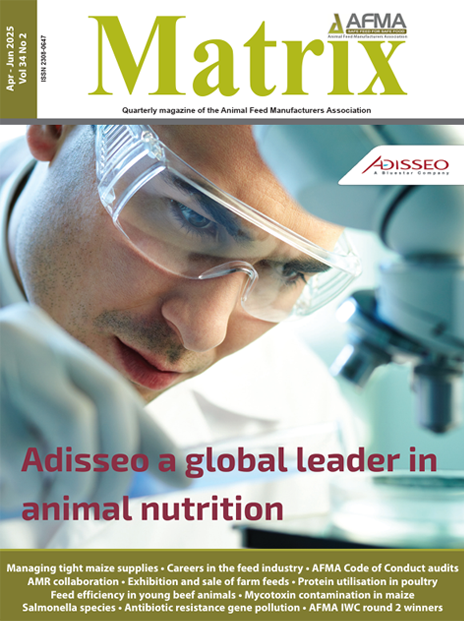
April - June 2025
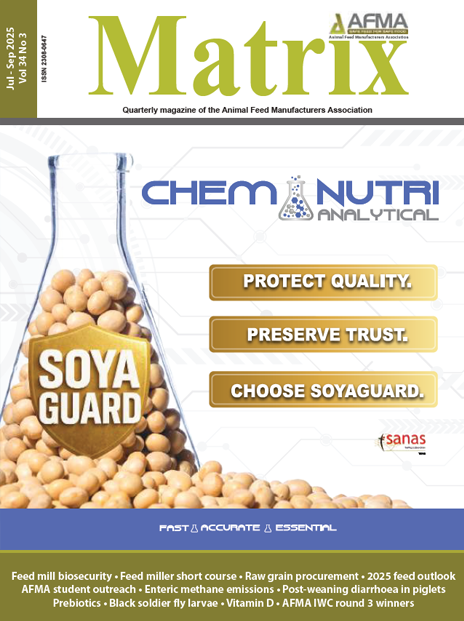
Jul. - Sept. 2025
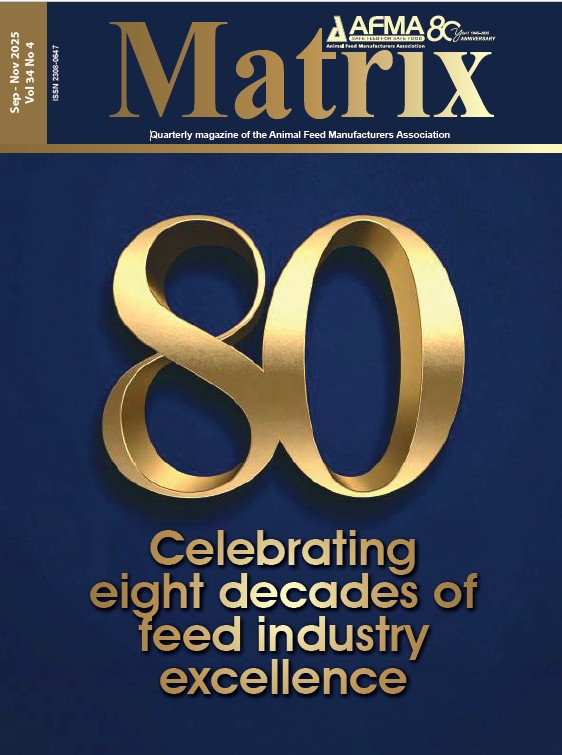
Oct. - Dec. 2025
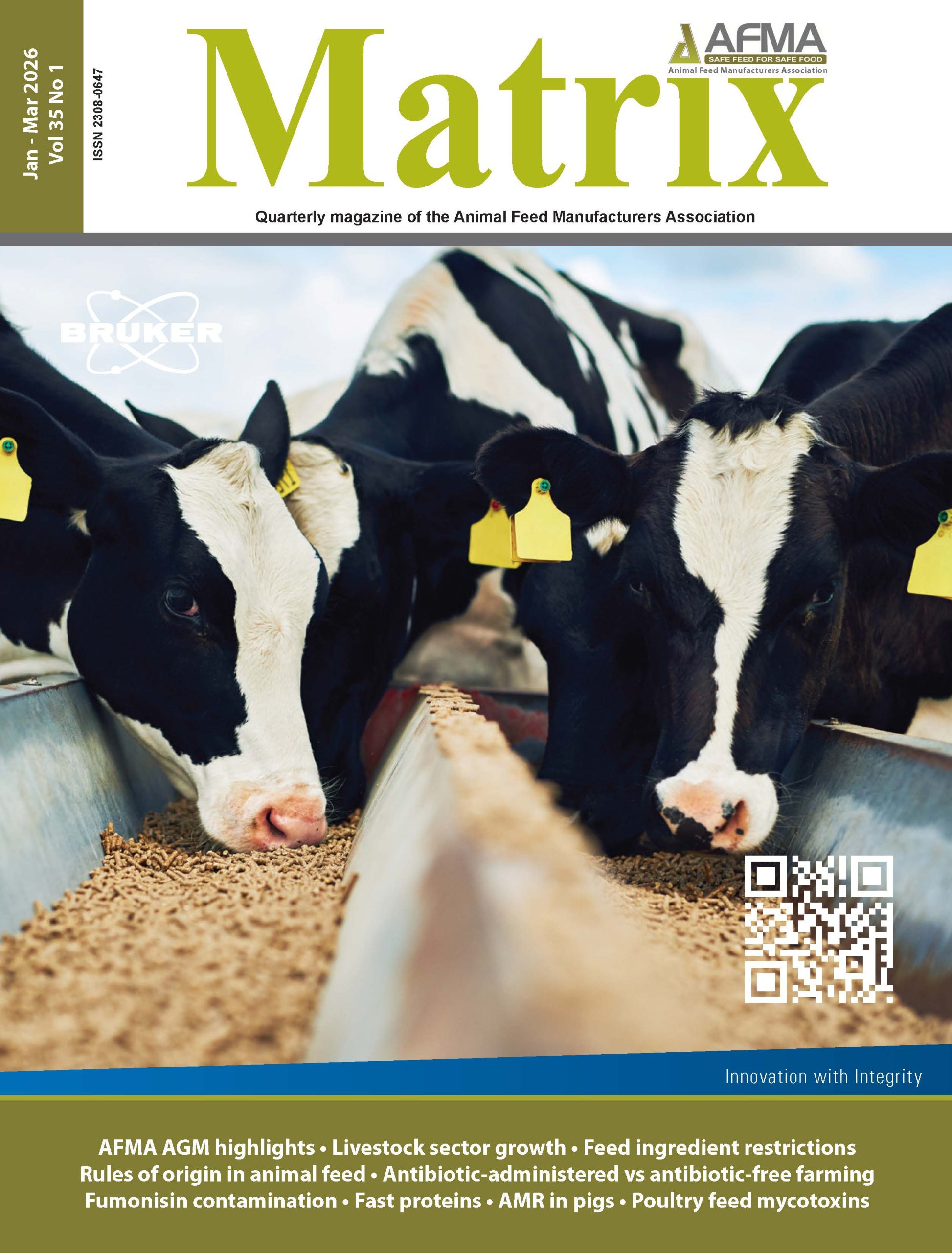
Jan. - Mar. 2026
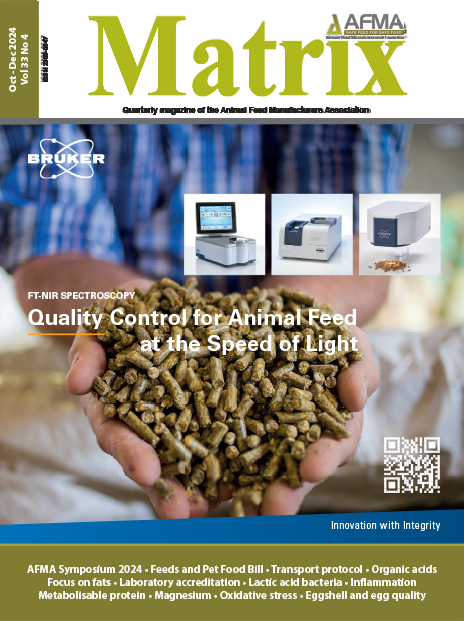
Oct. - Dec. 2024
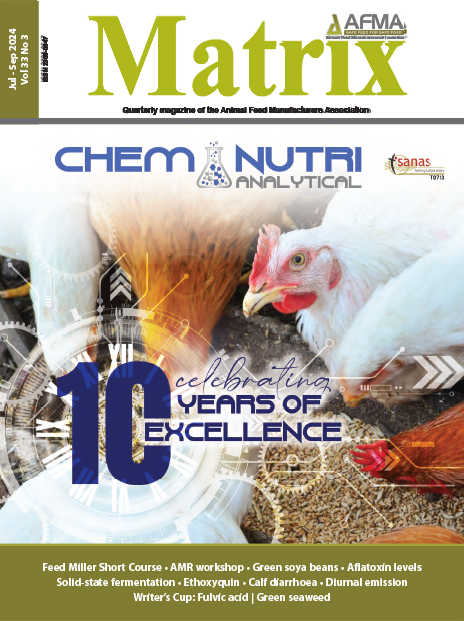
Jul. - Sept. 2024
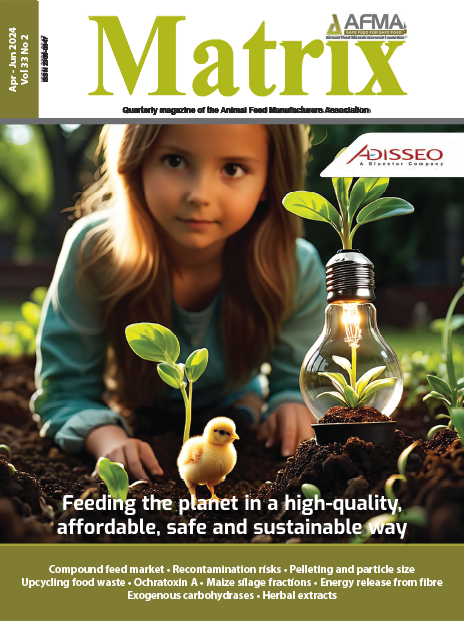
April - June 2024
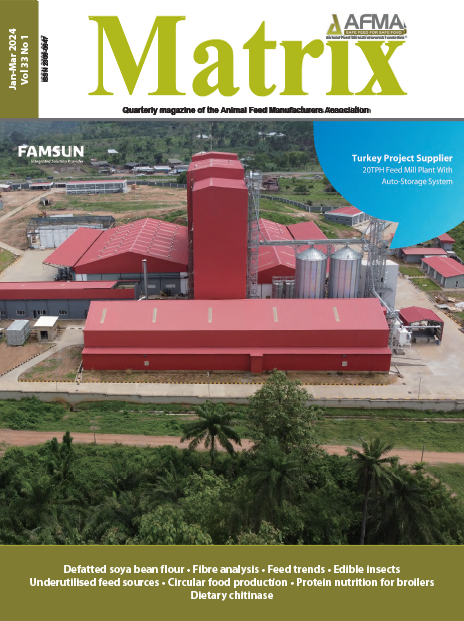
Jan. - Mar. 2024
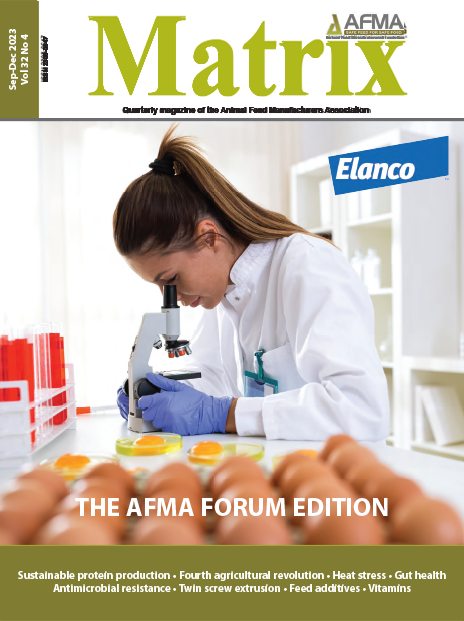
Oct. - Dec. 2023
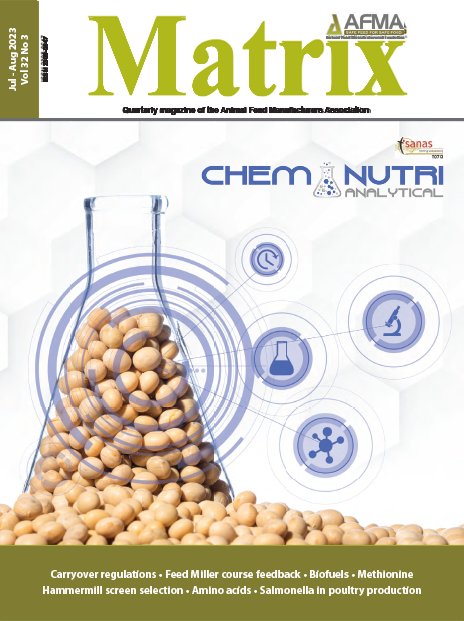
Jul. - Sept. 2023
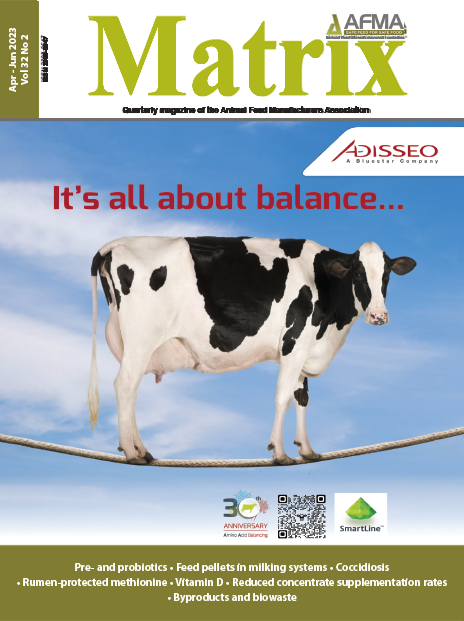
Apr. - June 2023
Vol 34 No 1 | January – March 2025
By Liesl Breytenbach, executive director, AFMA
At the start of any new year it is natural to embrace the possibility of opportunities.
It is a time to relook, rethink, replan, or just reinforce. The Animal Feed Manufacturers Association (AFMA) had a thorough relook at itself in 2019, the board of directors had a rethink, and AFMA’s vision was established as being a thought leader in animal feed. Little did we know what the next five years would bring. Covid-19 changed the way we live, do business and communicate, and forced us to re-evaluate what is important, critical, and essential. The uninterrupted provision of safe, nutritious, and affordable food was soon labelled as essential, and the animal feed sector found itself to be an integral essential service.
Almost five years later, and we have learned to adapt to a community that demands flexibility and choice by connecting virtually on many levels. The concepts of master plans, value chains, and roundtables have since become part of the South African agricultural strategy for growth. Industry role-players have all navigated towards a next-level structure of collaboration, dialogue, and information flow.
South African agriculture was the only sector to record impressive growth rates since the pandemic in 2020, showcasing its potential to pull the economy through times of crisis. During this time, the Agriculture and Agro-Processing Master Plan (AAMP) was drafted and the then Department of Agriculture, Land Reform and Rural Development (DALRRD), together with other industry partners, co-signed the AAMP in May 2022.
Disruptions in global commodity supply chains following the 2022 Russian-Ukrainian conflict, overall concerns regarding the stability of commodity markets and prices, and a drop in disposable income in the majority of G20 countries all contributed towards a decline in broader economic activity and emphasised the need to implement the initiatives of the AAMP in South Africa.
Towards the end of 2024, South Africa had the highest unemployment rate on the continent (32,1%), underscoring the critical need for intervention and solutions. The AAMP partners, of which AFMA is one, is wholly committed to finding solutions and have adopted the concept of commodity value chain round tables (VCRT) from Canada for the implementation of commodity strategies that will benefit the sector. The Grains VCRT was established and created a platform where fragmented relations between government, industry, business, and labour can be managed and moulded towards a true partnership.
This journey will continue and will initially not be a smooth one. The animal feed sector should practice patience, while remaining resilient and focussed on working together to find solutions. Naturally, the success of this initiative can only be confirmed through monitoring, evaluation and diligent reporting, a function and responsibility bestowed upon the National Agriculture Marketing Council (NAMC).
Besides wars, climate, and other worldwide crises contributing to higher food prices and increasing pressure on value chain stakeholders and consumers, South Africans also had to contend with limited basic electricity and increasing water supply problems, which ignited the resurgence of the old Afrikaans saying, ‘n boer maak ‘n plan. Part of this plan is to diversify our agricultural export markets to manage the risk and sustain a growing agricultural sector.
Not only is AFMA’s vision to be a thought leader in animal feed, but also to focus on influencing food security and making a lasting impact on the health and wellbeing of the population. The need for a balanced diet that includes animal protein is now more important than ever, and the animal feed sector can play an important role in the provision of affordable food. Initiatives such as VAT-free bone-in chicken and even offal will go a long way in addressing this dire need, but must be implemented effectively and controlled rigorously to avoid unintended consequences and the misuse of good intentions.
Having established strong networks throughout the grains and livestock value chains, AFMA is ideally suited to drive progress across various agricultural value chains. We will drive our strategy based on four pillars:
The members of AFMA are at the core of this strategy and 2025 is a great year to make a difference amid growing optimism regarding the government of national unity, improved electricity supply, better-priced input costs, easing in fuel prices, and the prospect of La Niña-induced rainfall in the 2024/25 summer season. Fuelled by positivity, we remain grounded and acknowledge the hard work ahead.
By Petru Fourie, operations manager, AFMA
South Africa’s meat consumption trends reflect changing consumer behaviours influenced by economic conditions, health considerations, and cultural shifts. In recent decades, the demand for more affordable protein sources such as poultry has surged, while per capita consumption of beef and mutton decreased. For feed manufacturers, understanding these patterns is essential for aligning feed production strategies with market demands. Remaining informed of these trends is crucial in meeting evolving demands and being able to adapt to potential shifts in consumer behaviour across the different meat categories.
Figure 1 illustrates the production versus consumption trends for meat (beef, mutton, goat, pork, poultry) in South Africa. Since around 2000, both meat production and consumption have significantly increased, driven largely by rising consumer demand for animal protein. Poultry has been the major contributor to this growth, given its affordability and relatively shorter production cycle compared to other meats such as beef. South Africa is not self-sufficient in terms of meat production, which is why the country has been a net importer of poultry since early 2000. Since around 2010, consumption has consistently outpaced production, reflecting a reliance on imports to meet local demand. In the case of beef, mutton and pork, the supply-demand gap has remained narrower, but poultry consistently relies more on imports.
The expansion of the livestock and poultry sector in South Africa has been integral to the development of the animal feed industry. This trend emphasises the importance for feed manufacturers to stay attuned to consumer demand, ensuring sustainable meat production levels and reducing reliance on imports.
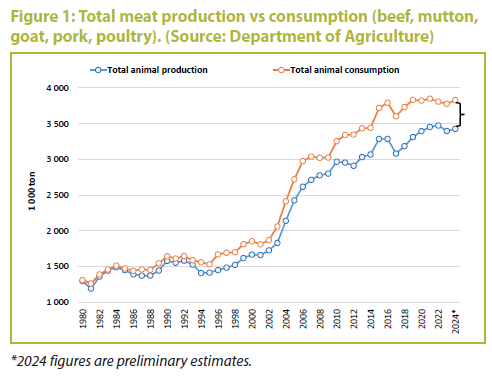
Figure 2 illustrates South Africa’s per capita meat consumption (including beef, mutton, goat, pork, poultry) from 1980 to 2024. The trend reflects shifts in consumer preferences and broader economic influences on meat consumption patterns. These shifts transformed the South African meat industry. From 1980 to the early 2000s total per capita meat consumption per year remained relatively steady, fluctuating between 40 to 45kg per person. However, after 2003 there was a sharp increase, with consumption jumping dramatically by approximately 40% over five years, reaching roughly 61,5kg per capita. This significant surge was primarily driven by increased poultry consumption, as chicken became an increasingly affordable and popular protein source compared to more expensive red meats such as beef and mutton.
However, after peaking in the early 2010s, total meat consumption appears to have stabilised, suggesting that per capita intake has reached a plateau as consumer purchasing power and dietary preferences continue to evolve. When analysing per capita meat consumption by specific meat types, several significant trends become apparent.
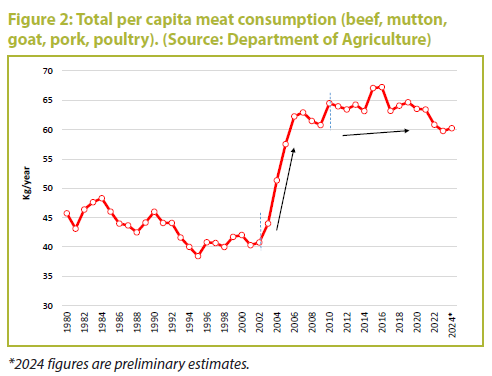
Figure 3 shows the per capita consumption patterns of various products in South Africa from 1980 to 2024, including meat, milk and eggs. Poultry consumption has shown significant growth, especially from 2000 onwards. Poultry per capita consumption almost doubled from 11,6kg/capita/year in 1980 to 21,7kg/capita/year in 2000, largely at the expense of red meat consumption (beef, mutton, goat), while pork consumption remained relatively stable at 3kg/capita/year during this time period. From 2000 to 2020, similar meat consumption composition changes were observed: chicken consumption increased further to 38,7kg/capita/year, contributing 60% of the total South African meat consumption in 2020. In contrast, the proportion of beef in the meat consumption composition decreased from 33% in 2000 to 26% in 2020. Mutton and goat per capita consumption decreased from 3,7kg/capita/year in 2000 to 3kg/capita/year in 2020, while pork consumption slightly increased to 5kg/capita/year in 2020.
Examining the per capita consumption trends for milk, eggs, beef and poultry from 2020 to 2024 (Figure 3) reveals a notable decline across all these products. To understand the potential reasons for this decrease, the following section explores the impact of price changes on consumer demand. By comparing the prices of these key products with their per capita consumption, we can identify whether rising costs have influenced purchasing behaviour.
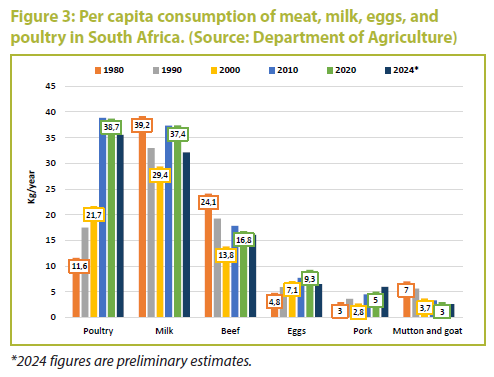
An index was compiled with 2020 as the base year to compare the prices of key products with their per capita consumption, providing a clearer analysis of the impact of price changes on consumption. The data presented in Figure 4 reflects a significant trend: the price of key protein sources – eggs, chicken, beef, and milk – has steadily increased from 2020 to 2024. However, per capita consumption of these items has declined over the same period. For instance, the price index for eggs and chicken portions shows an upward trajectory, while their per capita consumption (measured in kg/year) decreases. This pattern suggests that rising prices may be contributing to reduced consumer intake as households adjust their purchasing habits in response to affordability constraints.
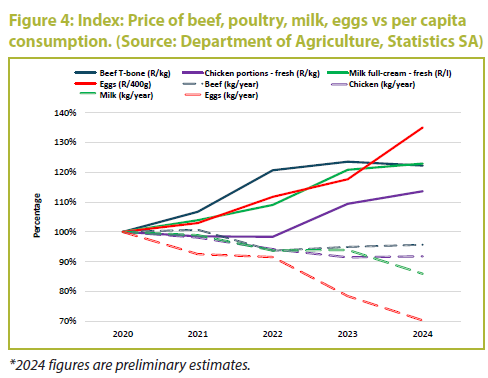
A similar trend can be observed with beef and milk. The T-bone beef price index increased, while beef consumption per capita decreased, indicating that higher beef costs might be limiting access to this protein source. For milk, despite its importance in daily nutrition, rising prices are paralleled by a reduction in per capita consumption. Overall, this trend of increasing prices coupled with declining consumption highlights a concerning pattern where inflation in food prices may be affecting the ability of South African consumers to maintain consistent protein intake.
The consumption trends in South Africa indicate a strong consistent demand for affordable protein sources, particularly poultry, which is expected to remain the primary focus for feed manufacturers. Rising prices across all meat categories impacted consumer purchasing power, placing more pressure on affordability and amplifying the demand for poultry. This aligns with the growing preference for pork and eggs, while demand for red meats such as beef and mutton continues to decline.
Going forward, closely monitoring changes in consumer behaviour that may affect future consumption patterns is crucial. As South Africa’s reliance on poultry imports underscores a supply gap, the animal feed manufacturers will continue to support and strengthen local production initiatives that could help reduce dependency on imports. In this dynamic environment, feed manufacturers have a pivotal role in supporting the livestock and poultry industry’s resilience by addressing affordability challenges to maintain steady protein intake levels for all South Africans.
By Wimpie Groenewald, membership liaison officer, AFMA, and Joe Hanekom, managing director, Afri Compliance
The Animal Feed Manufacturers Association (AFMA)’s Code of Conduct provides essential guidelines to promote ethical, safe, and sustainable practices in the animal feed industry. This code reflects AFMA’s commitment to advancing product quality, consumer confidence, and environmental stewardship while supporting industry innovation and regulatory compliance. The code sets a benchmark for responsible conduct among AFMA full and associate members and aligns the sector with broader food safety and sustainability goals.
The AFMA Code of Conduct serves as a foundational guide for responsible feed manufacturing. It is not a certification nor does it replace any quality certifications or standards such as ISO 22000. The following sections highlight the core principles of the code, reinforcing AFMA’s commitment to integrity and consumer trust.
Ensuring quality and safety standards: A cornerstone of the AFMA Code of Conduct is its emphasis on quality and safety standards in feed production. AFMA members adhere to regulations and best practices designed to ensure the safety of animal feed, thereby protecting both animal health and human food safety. The code requires feed manufacturers to control hazards and prevent contaminants, ensuring that the final product is safe for livestock and humans.
Promoting ethical business practices: The AFMA Code of Conduct underscores the importance of ethical business behaviour, advocating for honesty, transparency, and fairness. This includes maintaining accurate advertising and clear labelling to prevent misleading consumers. By promoting these principles, AFMA supports fair competition and builds trust with the public and industry partners.
Advocating for animal welfare: Animal welfare is integral to AFMA’s mission. The code reflects this commitment by promoting the manufacture of balanced, nutrient-rich feeds that support animal health and well-being. By emphasising proper nutrition, the code encourages feed manufacturers to meet ethical standards that enhance farm animal welfare.
Sustainability: AFMA is committed to sustainable feed production, urging members to adopt practices that reduce waste and conserve resources across the food chain.
Building Consumer Confidence: The AFMA Code of Conduct symbolises quality and reliability. By adhering to the code, AFMA members reinforce public trust in the safety and integrity of animal feed products, supporting the stability of the agri-food sector. The AFMA quality logo, displayed by members who meet the code standards, is recognised as a mark of safe and ethically produced feed.
Feed safety – a prerequisite for food safety: The AFMA Code of Conduct recognises that feed safety is crucial for food safety. Contaminants in animal feed can pose risks to both animal and human health, making it essential to maintain strict safety protocols throughout the production chain. By aligning feed manufacturing with integrated food safety systems, AFMA contributes to a safer food supply and supports public health.
Co-operation in the agri-food value chain: The code encourages collaboration among all stakeholders in the agri-food chain to ensure the safety and quality of animal feed. Each participant in the value chain, from raw material suppliers to final product distributors, shares responsibility for maintaining high standards and controlling hazards. This co-operation fosters transparency and instils confidence among consumers who depend on a safe food supply.
In 2017, AFMA embarked on a significant modernisation of its code of conduct to address evolving industry needs and regulatory requirements. This revision introduced updates to the compliance protocol, audit processes, and membership procedures, making the code more effective and accessible for members. The Covid pandemic effectively halted the first phase of the revised code’s implementation.
The modernisation was driven by two primary factors:
The following aspects will be addressed in the modernised code of conduct, with implementation planned in stages:
AFMA’s phased implementation of the revised code of conduct protocol is already underway, with audit renewals that resumed after the pandemic delays. The following progress has been made with the implementation of the modernised AFMA Code of Conduct, with the resources available:
This modernisation strengthens AFMA’s self-regulation framework and establishes the organisation as a leader in feed safety and regulatory compliance, being the only voluntary organisation with a mandatory industry standard required for AFMA membership. By adopting this updated code, AFMA members show their dedication to delivering safe, high-quality feed responsibly and sustainably. The AFMA Code of Conduct, with its emphasis on biosecurity, consumer safety, and ethical practices, lays a strong foundation for feed safety, food security, and industry accountability. Through its continuous evolution, the code ensures that AFMA members remain at the forefront of safe and responsible feed production, contributing to a trustworthy and resilient agri-food value chain
By Wimpie Groenewald, membership liaison officer, AFMA, and Joe Hanekom, managing director, Afri Compliance
The Animal Feed Manufacturers Association (AFMA)’s Code of Conduct provides essential guidelines to promote ethical, safe, and sustainable practices in the animal feed industry. This code reflects AFMA’s commitment to advancing product quality, consumer confidence, and environmental stewardship while supporting industry innovation and regulatory compliance. The code sets a benchmark for responsible conduct among AFMA full and associate members and aligns the sector with broader food safety and sustainability goals.
The AFMA Code of Conduct serves as a foundational guide for responsible feed manufacturing. It is not a certification nor does it replace any quality certifications or standards such as ISO 22000. The following sections highlight the core principles of the code, reinforcing AFMA’s commitment to integrity and consumer trust.
Ensuring quality and safety standards: A cornerstone of the AFMA Code of Conduct is its emphasis on quality and safety standards in feed production. AFMA members adhere to regulations and best practices designed to ensure the safety of animal feed, thereby protecting both animal health and human food safety. The code requires feed manufacturers to control hazards and prevent contaminants, ensuring that the final product is safe for livestock and humans.
Promoting ethical business practices: The AFMA Code of Conduct underscores the importance of ethical business behaviour, advocating for honesty, transparency, and fairness. This includes maintaining accurate advertising and clear labelling to prevent misleading consumers. By promoting these principles, AFMA supports fair competition and builds trust with the public and industry partners.
Advocating for animal welfare: Animal welfare is integral to AFMA’s mission. The code reflects this commitment by promoting the manufacture of balanced, nutrient-rich feeds that support animal health and well-being. By emphasising proper nutrition, the code encourages feed manufacturers to meet ethical standards that enhance farm animal welfare.
Sustainability: AFMA is committed to sustainable feed production, urging members to adopt practices that reduce waste and conserve resources across the food chain.
Building Consumer Confidence: The AFMA Code of Conduct symbolises quality and reliability. By adhering to the code, AFMA members reinforce public trust in the safety and integrity of animal feed products, supporting the stability of the agri-food sector. The AFMA quality logo, displayed by members who meet the code standards, is recognised as a mark of safe and ethically produced feed.
Feed safety – a prerequisite for food safety: The AFMA Code of Conduct recognises that feed safety is crucial for food safety. Contaminants in animal feed can pose risks to both animal and human health, making it essential to maintain strict safety protocols throughout the production chain. By aligning feed manufacturing with integrated food safety systems, AFMA contributes to a safer food supply and supports public health.
Co-operation in the agri-food value chain: The code encourages collaboration among all stakeholders in the agri-food chain to ensure the safety and quality of animal feed. Each participant in the value chain, from raw material suppliers to final product distributors, shares responsibility for maintaining high standards and controlling hazards. This co-operation fosters transparency and instils confidence among consumers who depend on a safe food supply.
In 2017, AFMA embarked on a significant modernisation of its code of conduct to address evolving industry needs and regulatory requirements. This revision introduced updates to the compliance protocol, audit processes, and membership procedures, making the code more effective and accessible for members. The Covid pandemic effectively halted the first phase of the revised code’s implementation.
The modernisation was driven by two primary factors:
The following aspects will be addressed in the modernised code of conduct, with implementation planned in stages:
AFMA’s phased implementation of the revised code of conduct protocol is already underway, with audit renewals that resumed after the pandemic delays. The following progress has been made with the implementation of the modernised AFMA Code of Conduct, with the resources available:
This modernisation strengthens AFMA’s self-regulation framework and establishes the organisation as a leader in feed safety and regulatory compliance, being the only voluntary organisation with a mandatory industry standard required for AFMA membership. By adopting this updated code, AFMA members show their dedication to delivering safe, high-quality feed responsibly and sustainably. The AFMA Code of Conduct, with its emphasis on biosecurity, consumer safety, and ethical practices, lays a strong foundation for feed safety, food security, and industry accountability. Through its continuous evolution, the code ensures that AFMA members remain at the forefront of safe and responsible feed production, contributing to a trustworthy and resilient agri-food value chain
Vol 34 No 2 | April – June 2025
By Liesl Breytenbach, executive director, AFMA
It’s hard to believe that we are already several months into 2025 – and so far the year has really kept us on our toes! With so many moving parts in our industry, the saying ‘time does not wait for anyone’ has never been more relevant. Fortunately, the recent rainfall over key summer grain areas have helped to ease some early concerns, and with the latest Crop Estimates Committee (CEC) figures showing an increase in maize and soya bean production (up from 2024’s figures) we now have a clearer picture of what to expect in the months ahead.
While production estimates are higher than in the previous season, stock levels for most summer grains remain tight. The eventual supply-demand situation will depend on export demand from neighbouring countries, which will play a critical role in feed ingredient availability and price trends. The animal feed industry is never short of challenges, but each one presents an opportunity for innovation, resilience, and collaboration. Whether it is navigating logistical hurdles at our ports or adapting to regulatory developments, one thing remains clear: We are all in this together.
A key focus in the April issue of AFMA Matrix is ongoing port inefficiencies and their impact on the feed industry. Supply chain disruptions have made one thing very clear: Efficient import and export logistics are critical for maintaining feed availability and cost stability. While these challenges are not new, the urgency to address them has never been greater.
We also explore the Animal Feed Manufacturers Association or AFMA’s recent introduction of remote audits as part of its Code of Conduct assessment process. This enhancement allows for a more flexible and efficient auditing approach for specific member categories such as traders without warehousing, and certain Southern African Development Community (SADC)-based manufacturers. By integrating remote audits, AFMA continues to uphold high industry standards while streamlining compliance verification in a practical and cost-effective manner.
Perhaps some of the most rewarding developments have been various discussions in our internal AFMA committee meetings. These are invaluable engagement platforms where all members share input, identify challenges, and participate in finding solutions. These meetings are crucial for the entire industry because they give us the space to step back, take stock of our progress, and ensure that projects and strategic focus areas are moving in the right direction.
AFMA continues to strengthen the value chain through collaboration in the grain value chain network roundtable, addressing key issues such as supply chain efficiencies, market access, and the adoption of innovative technologies to enhance productivity. Additionally, AFMA is in the early stages of engaging with the livestock value chain roundtable under the Agriculture and Agro-processing Master Plan (AAMP) and is looking forward to contributing to industry-led solutions that drive efficiency and resilience in the livestock sector.
As challenges evolve, biosecurity remains a fundamental priority. Preventing disease spread and ensuring feed safety are essential for a resilient and sustainable feed sector. AFMA is dedicated to keeping members informed and updating the industry on key biosecurity initiatives. Strengthening biosecurity across the value chain goes beyond compliance – it is a vital aspect to protecting the long-term future of our industry. On the topic of global challenges, antimicrobial resistance (AMR) continues to be a significant concern and therefore AFMA is actively engaging with stakeholders in a unified AMR Alliance. Collaboration between regulators, veterinarians, and feed manufacturers is critical in shaping responsible antimicrobial use policies that safeguard both animal and human health.
We know that reliable crop estimates will continue to be invaluable for the feed industry, influencing everything from pricing to procurement strategies. This edition takes a closer look at the CEC’s performance of the past seasons with regard to maize, soya bean, and sunflower crops, because accurate data in our industry is not only helpful – it’s essential.
Beyond the numbers and technical discussions, this issue also shines a light on something that is close to my heart: career development in the feed industry.
Whether you are a student looking to enter the field, a feed mill operator seeking to develop practical skills, or a company searching for the right talent, AFMA’s training and skills initiatives and collaborations strive to cultivate the next generation of experts. In this industry, the chicken that stays informed stays at the top of the pecking order. This issue of AFMA Matrix is sure to contribute to the knowledge and insights needed to do precisely this.
At the end of the day, what makes this industry special is its people. The dedication, problem-solving, and drive to keep moving forward, despite numerous challenges, are what make our collective efforts so impactful. I encourage you to dive into this issue, reflect on the discussions and, most importantly, join the conversation that is shaping our industry’s future.
By Petru Fourie, operations manager, AFMA
Maize serves as the cornerstone of South Africa’s feed industry, forming the foundation of livestock and poultry nutrition. As the largest single ingredient in animal feed formulations, fluctuations in its supply, pricing, and availability have significant implications for feed manufacturers and livestock producers. The importance of maize in feed production cannot be overstated – it is an energy-dense, cost-effective component in feed rations, making it indispensable in large-scale feed manufacturing.
The past few years have been challenging for the feed industry due to increased maize price volatility, largely driven by the impact of climate conditions on crop production. These factors have tightened maize supplies, prompting feed manufacturers to reassess procurement strategies and adapt to an increasingly uncertain market.
The 2024/25 marketing season has already seen record-high maize consumption levels, with 2025/26 estimates pointing to further supply pressures. Given these realities, feed manufacturers must evaluate strategies to mitigate risks, optimise feed formulations, and ensure supply stability. The purpose of this article is to examine the current challenges associated with the supply of yellow maize, a crucial ingredient in the feed industry.
South Africa produces an average of 15 million tonnes of maize annually with white maize primarily consumed as a staple food while yellow maize remains a critical component of the animal feed sector. The local feed industry consumes on average 5,87 million tonnes of maize per year, with 4,57 million tonnes (78%) being yellow maize and 1,3 million tonnes (22%) white maize. During the past five years, an average of 65% of total yellow maize production has been used for feed. However, for the 2024/25 and 2025/26 seasons, this figure is projected to increase significantly to 96%.
Of the total feeds produced, the poultry sector accounts for nearly 40% while the pig, beef, and dairy industries also rely on maize-based feeds. The demand for maize-based feed has steadily increased over the years due to an increase in consumer demand for affordable animal protein, making maize an integral part of the entire agricultural value chain. As a result of recent drought conditions, maize production has become increasingly unpredictable with major shifts in planting patterns, and the global market also contributing to supply uncertainty. As yellow maize represents a large percentage in feed composition, any disruptions in production or price surges directly impact feed costs, ultimately affecting livestock producers.
According to data by the South African Grain Information Service (Sagis) and the National Agricultural Marketing Council (NAMC), the long-term trends seen in South African yellow and white maize consumption for animal feed showed a steady increase in yellow maize usage alongside fluctuating white maize consumption driven by price and availability (Figure 1).
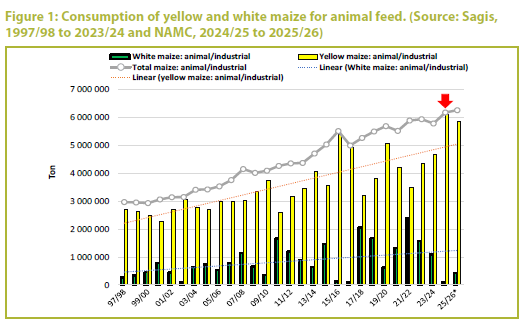
In the 2024/25 marketing year, yellow maize consumption in animal feed reached a record-high level of 6,1 million tonnes.
This surge was primarily driven by a tight white maize supply, following drought conditions that severely impacted white maize production. On average, white maize prices traded more than R1 000/ton higher than yellow maize, reinforcing yellow maize as the preferred choice for feed manufacturers. With poultry remaining the dominant consumer of feed, yellow maize consumption is expected to remain strong throughout the 2025/26 marketing season. This strong demand also has its challenges as the industry faces production shortfalls and price volatility. Feed manufacturers must closely monitor supply trends and adjust procurement strategies accordingly to steer potential market shifts.
This section focusses specifically on yellow maize given its dominant role in the animal feed industry. One of the most pressing challenges at the start of the 2025/26 marketing year is the low opening stock levels of 385 498 tonnes – indicating a drastic decline from 1 058 million tonnes in 2024/25. This significantly low stock level creates immediate supply pressures, particularly in a year when the CEC’s first yellow maize production estimate is approximately 11% lower than the previous five-year average. Looking at historical trends, the last time South Africa’s yellow maize opening stocks were this low was in the 2014/15 marketing year, a period also marked by severe drought conditions that impacted production. As a result, the current market conditions reflect similar supply constraints, leading to reduced carry-over stocks and market uncertainty.
In order to meet local demand, yellow maize imports are therefore expected to increase significantly – from 32 844 tonnes in the 2023/24 marketing year, with the following season’s 730 000 tonnes, to an early projection of 1,1 million tonnes in 2025/26. This shift from being a net exporter of maize to importing puts pressure on feed manufacturers, particularly increasing exposure to currency fluctuations which directly impact the landed cost of imported maize.
Yellow maize exports are projected to decline sharply from 2,3 million tonnes in 2023/24 to only 720 000 tonnes in 2025/26, further highlighting the strain on local supply availability. The ultimate impact on the supply-demand balance will largely depend on demand from neighbouring countries. For feed manufacturers, these dynamics increase uncertainty and cost pressures, requiring proactive procurement and risk management strategies to secure raw materials at competitive prices.
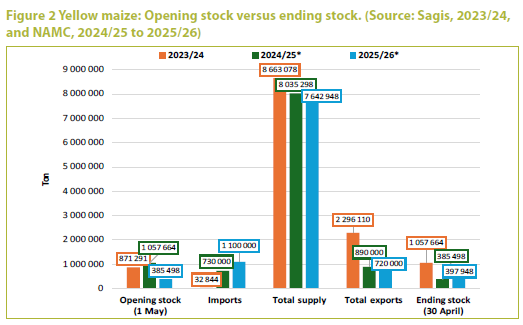
Despite prevailing tight supply fundamentals, yellow maize prices on the South African Futures Exchange (Safex) have declined significantly since 27 January this year. Maize prices across all contract periods – March 2025, May 2025, and July 2025 – have fallen, ranging from more than R1 000 per ton over a five-week period (until the time of writing this article) for the March 2025 contract month compared to almost R400 for the May 2025 and July 2025 contract prices.
While market sentiment and fundamental factors, including low stock levels and increased import dependence, suggest continued price support for the upcoming marketing season, recent downward movements indicate that short-term market forces have temporarily outweighed underlying supply constraints. While fundamentals still indicate long-term supply constraints, the recent correction suggests that short-term liquidity pressures, improved production outlooks due to the February rains, and a shift in contract focus played a more immediate role in driving prices lower.
Although the July 2025 Safex yellow maize contract price is, at the time of writing, trading just above R4 000/t, the prevailing supply constraints indicate that prices could trend towards import parity levels, which are currently approximately R5 100/t.
For feed manufacturers, this sudden price shift presents both risks and opportunities. On the one hand, the decline provides temporary relief on input costs, creating a window for strategic purchasing. However, the fundamental supply outlook remains constrained, and any adjustments in crop estimate figures, unexpected production shortfalls, or renewed global market pressures could lead to a price rebound in the coming months. With maize accounting for 60 to 70% of total feed costs, such price fluctuations have major implications for the entire feed industry. The ability to analyse Safex trends and anticipate future price movements will be critical in maintaining cost-efficiency and securing raw materials at competitive prices.
As South Africa’s feed industry continues to grapple with tight maize supplies, price volatility, and shifting market dynamics, it is crucial for feed manufacturers to remain proactive and adaptable in their procurement strategies. The record-high yellow maize consumption in 2024/25, coupled with historically low stock levels and increased import dependence, highlights the challenges facing the industry as it moves into the 2025/26 marketing season. As South Africa’s feed industry steers towards tight maize supplies, proactive market monitoring and strategic planning are more critical than ever. High maize consumption coupled with lower-than- average stock levels are highlighting the urgency to ensure a reliable and cost-effective maize supply to sustain feed manufacturing – and the broader livestock industry.
It is important to note that the insights shared in this article are based on the first production estimates from the CEC. The transition from being a net exporter of maize to having to import further exacerbates this challenge and exposes feed manufacturers to currency risks and global market fluctuations.
By Petru Fourie, operations manager, AFMA
The 2023/24 planting season in South Africa started with adequate early rainfall that enabled timely planting. However, a mid-summer drought in January and February last year led to prolonged heat and dryness, reducing yield potential and resulting in below-average yields. The impact of these conditions is evident in last year’s maize crop which, at an estimated 12,85 million tonnes, marks the smallest total maize crop in five years, making it the lowest since 2019 (11,275 million tonnes). This has direct implications for the animal feed industry, as maize remains a crucial ingredient in livestock feed production. Feed millers rely on stable maize supplies and accurate crop estimates to manage raw material procurement, cost structures, and production planning, all of which become more complex in volatile production seasons.
This article provides an in-depth review of the crop estimation process for the 2023/24 season, analysing how the Crop Estimates Committee (CEC) adjusted its forecasts from the first production estimate in February last year to the final actual estimate in February this year for maize, soya bean and sunflower seed. Accurate and timely estimates are fundamental to market price formation, feed supply planning, and ensuring stability in the agricultural sector, particularly in volatile seasons such as 2023/24.
Figure 1 illustrates the monthly production estimates for yellow maize from February to November last year, as released by the CEC. The red line represents the final realised yellow maize production figure of 6,795 million tonnes. The initial estimate in February last year was 7,318 million tonnes, as the season started relatively well, but due to the challenging mid-season drought conditions, the final crop size was adjusted downward by 523 400 tonnes. The CEC’s swift response to changing conditions and their ability to filter updated information into their estimates is commendable. This is evident in the immediate adjustment of the February estimate to the March estimate. While fluctuations occurred throughout the season, the CEC’s projections gradually aligned with the final production figure, demonstrating their commitment to accurate and responsive forecasting. For feed millers, yellow maize is a critical input in animal feed production, influencing raw material procurement, price volatility, and supply chain planning. A smaller than expected maize crop directly affects feed availability and costs, thus making accurate crop estimates even more essential for planning.
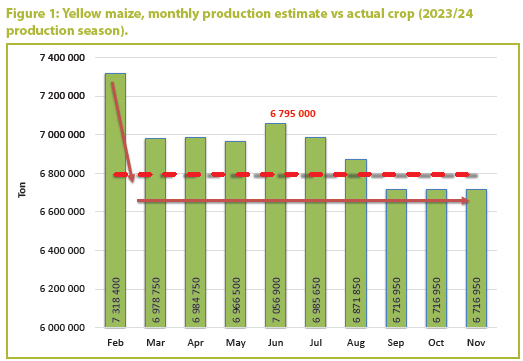
Figure 2 presents the monthly production estimates for white maize throughout the 2023/24 production season. Similar to yellow maize, the CEC initially estimated a relatively high crop, but its estimates were quickly adjusted to take into account the impact of the drought conditions. As the drought conditions were more severe in the western parts of South Africa compared to the eastern regions, the impact of the drought was more pronounced in white maize compared to yellow maize. The initial estimate in February last year was 7,041 million tonnes, but due to the challenging conditions, the final crop size was revised downward by 985 500 tonnes.
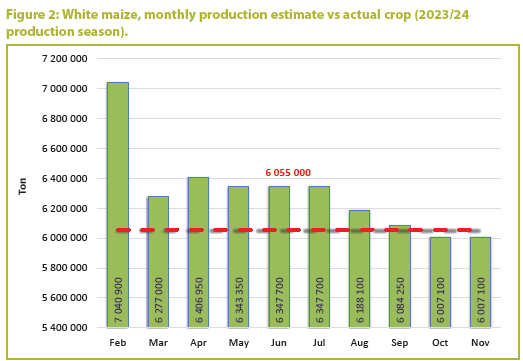
In South Africa, the grain industry has set a standard/norm of accuracy for the CEC within which crop estimates must range. Specifically, from the first to the fourth estimate (February to May), deviations from the actual crop estimate should not exceed 8%, and from the fifth to the final estimate (June to November), deviations should not exceed 5%. The CEC must operate within acceptable upper and lower norms and if an estimate deviates beyond these limits, it may in retrospect be classified as an over- or underestimation.
Yellow maize estimates consistently remained within the acceptable norms, demonstrating a high level of accuracy. However, white maize posed a greater challenge, with the first estimate significantly overestimated. This initial overestimation of the white maize crop also caused the total maize estimate to exceed the norm during the first round of projections.
Despite this, the CEC quickly adjusted its estimations, and from the second estimate onward all projections remained predominantly within the acceptable range. This reflects the CEC’s ability to refine its estimates as more accurate data became available, ensuring reliable estimations for the industry.
Soya bean plays an increasingly vital role in South Africa’s agricultural and feed sectors, articularly as a protein source for animal feed. The accuracy of soya bean production estimates is essential for feed manufacturers to manage soya bean meal supply and price stability. Figure 3 shows the monthly production estimates for soya bean during the 2023/24 production season. The CEC initially overestimated the soya bean crop in February, with the first estimate at 2,139 million tonnes. However, from the second estimate, the crop size aligned well with the final actual production figure as released on 13 February. This actual production figure indicates a decrease of 291 480 tonnes from the initial February estimate.
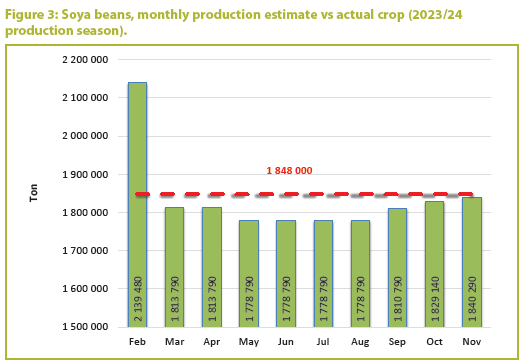
With the standards and norms already discussed for maize, it is evident that the CEC followed a similar trend for soya bean. The first estimate was overestimated, but subsequent estimates remained within the industry’s given norms of accuracy. Overall, the CEC performed exceptionally well, maintaining accuracy and staying within the required limits.
The CEC’s first estimate for the sunflower seed crop (February last year) was 671 100 tonnes. As the mid-summer drought set in, the CEC lowered its production estimate in March and April last year. However, as the season progressed, the estimates were gradually revised upward before stabilising near the final actual crop figure. Despite initial variations, the estimates remained accurate, aligning closely with the actual crop size. The CEC performed remarkably well in estimating the sunflower crop the past season, maintaining accuracy within the industry-prescribed norms from the beginning despite a challenging season. Their estimates consistently adjusted towards the final figure, demonstrating reliability in the estimation process.
The 2023/24 season posed significant challenges for agriculture in South Africa, with drought conditions leading to the smallest maize crop in five years. Despite a challenging season, the CEC demonstrated adaptability and accuracy, adjusting estimates as new data became available and predominantly staying within industry norms.
As illustrated in this article, the CEC’s strong performance provides a sense of confidence, demonstrating its ability to accurately estimate crop sizes. The timely release of precise crop estimates remains crucial for inter alia feed millers and industry stakeholders, as it directly influences raw material prices, procurement strategies, cost management, and production planning in the animal feed sector.
By Wimpie Groenewald, membership liaison officer, AFMA, and Joe Hanekom, managing director, Afri Compliance
The Animal Feed Manufacturers Association (AFMA) has recently revised its auditing protocol to provide a more functional and logistically flexible auditing process. A key enhancement includes the introduction of remote audits for specific categories of members, namely traders who do not use warehousing and move products directly from the ship to the client; and manufacturing facilities located in neighbouring Southern African Development Community (SADC) countries that do not export feed products to South Africa.
The new provision for remote audits aligns with AFMA’s commitment to maintaining a high industry standard with a robust risk-based approach, while offering a practical and cost-effective compliance verification method. This audit is a self-regulating mechanism that verifies compliance of all AFMA full and associate member facilities with the relevant legal requirements and industry standards related to animal feed and feed manufacturing. The audit process promotes integrity and consumer confidence within the animal feed and food sectors.
Traditionally, the AFMA Code of Conduct audit requires an on-site assessment conducted every two years by an independent auditor. The process includes:
The industry Code of Conduct was initiated in 2008 and since then, all AFMA feed manufacturers and feed ingredient suppliers have shown continuous compliance with the industry code, creating a responsible industry that provides safe feed for safe food. AFMA has initiated a modernisation of the Code to ensure its continued relevance, and as part of the re-assessment process, remote audits were adopted as acceptable audit protocols for qualifying members.
Remote audits use electronic methods to obtain evidence and evaluate conformity to audit criteria, and can include sharing files via email, OneDrive, or Google Drive; video conferencing by using tools such as Microsoft Teams and Zoom; or live video or surveillance video to gather evidence.
Remote auditing is useful for any kind of audit where evidence is gathered via documentation review, records evaluation, and interviews with people. This requires certain arrangements for the location of the auditor and safe and reliable technology. Remote audits are acknowledged by ISO 17065 as a standard auditing process and have been adopted by AFMA as part of its Code of Conduct audit protocol for certain membership categories. These audits are designed to deliver the same outcome as an on-site audit and is based on the same audit criteria. Remote audits are especially efficient for reviewing documents and records at facilities where no product is manufactured and/or stored.
AFMA management, in conjunction with the assessment body, thoroughly evaluated the risk of adopting remote audits as part of the Code of Conduct audit protocol, and have identified two membership categories where this will be allowed, as well as a set of criteria to determine eligibility.
New members: It is important to note that the first audit for ALL new (provisional) members will be an on-site audit and determines a risk profile for the business. Subsequent audits during the next audit cycle at trading companies and SADC manufacturers may qualify for a remote audit subject to AFMA approval. SADC manufacturers may only qualify for a remote audit every alternate audit cycle.
Existing members: Traders (without warehousing) may opt for a remote audit in the next renewal cycle following implementation. Eligibility for remote audits will be discussed during the pre-screening assessment with AFMA before each renewal, and written confirmation will be given upon approval. AFMA then notifies the assessment body when a remote audit process has been granted, based on the information gathered during the pre-screen process and previous audit risk assessments.
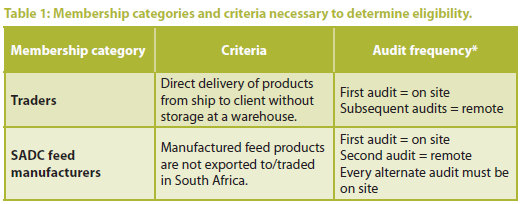
It is often overlooked that farm feed product specifications and safety must be upheld throughout the process, from manufacturing in the feed mill until presentation to an animal for consumption. This also includes the storage and transportation of feed products. The registration holder of a farm feed is therefore responsible by law to guarantee product compliance throughout the supply chain. The AFMA Code of Conduct was designed to independently verify member compliance across the whole supply chain – from ingredients used in feed manufacturing, its transport and storage, the manufacturing process, to the storage and transport of the finished product to the animal. It is clear that warehousing is an integral part of the process, and AFMA members have proven to store products under good warehousing practices that support the integrity and safety of animal feed. All warehouses subjected to a Code of Conduct audit are listed on the AFMA certificate issued to compliant member companies. Clients and consumers can obtain assurance that product safety and integrity were maintained during storage at all compliant AFMA members. Physical verification (on site) is needed to ensure that feed products are stored effectively, and hence the reason why remote audits will only be granted for members that do not make use of warehousing as part of their distribution.
Proper preparation for an audit is crucial to facilitate an efficient process. This is also true for remote audits and includes reviewing operational compliance with the AFMA Code of Conduct audit criteria; ensuring all required documentation is organised and available for the audit; preparing staff for virtual assessments; ensuring availability of effective technology to conduct virtual assessments; and co-ordinating with the assessment body in advance.
The introduction of remote audits was implemented on 1 March. AFMA is fully committed to enhance the industry’s ability to manage risk via the Code of Conduct and to assure our clients and consumers that AFMA members contribute responsibly to the animal agricultural value chain. Further developments in the modernisation of the Code of Conduct are expected this year, including the introduction of an updated audit scope based on FSSC 22000 principles, and additional assessment bodies that will be approved for auditing against the AFMA Code of Conduct.
By Lynette Louw
Dirk Bezuidenhout was involved in the livestock industry for more than 30 years, 15 of which he spent working for Afri Compliance. He was part of a team responsible for conducting specialist audits and verifying quality standards for agricultural establishments. In 2008, the Animal Feed Manufacturers Association (AFMA) adopted the AMFA Code of Conduct (CoC). Afri Compliance was contracted to serve as the independent auditing body to perform the compliance audits relating to the CoC.
Dirk was part of this process from the start. The audits entail ensuring that feed manufacturers meet regulatory requirements and quality standards set out in the CoC. In his role as an auditor, Dirk witnessed first-hand how an industry with a shared goal could succeed in meeting and sustaining the highest of standards.
The auditing process ensures that aspects such as transparency, traceability, honest business practices, adherence to regulations, responsible raw material use, respect for human capital, the promotion of sound working conditions, and more are entrenched in feed manufacturing processes. “Ultimately the AFMA Code of Conduct logo became a mark of integrity. The entire process of manufacturing safe feed to ensure safe food means consumers can rest assured that the highest quality standards were met.”
Dirk’s high school career at Brits Agricultural High School (now Wagpos) in North West laid the foundation for his passion for the livestock industry. When he joined Afri Compliance after serving at Agri Inspec, he learned a lot from his colleagues, especially Herman van Zyl, whose knowledge of the feed industry served as an inspiration and enormous source of information.
Dirk is passionate about the value of maintaining high standards: “It is about much more than adhering to rules and regulations. It is also about an ethical responsibility and ensuring quality as it affects both animal and human health. The CoC assists producers in meeting their ethical obligations. Producers have very little margin for error as almost 70% of their input costs revolve around animal feed and getting their animals market-ready. They have to be able to rely on a trustworthy, well-regulated feed industry.”
Third-party auditing, he says, ensures an independent, neutral process. “We know that state organs do not have the capacity to perform all their duties and that is where we can, and certainly do, makea difference. We strive to perform these auditing duties to the highest standards possible, and this is evident in the standard of feed manufacturing witnessed at AFMA members’ facilities. AFMA members follow the correct procedures, and they have us to ensure that it remains this way. Nowadays there are even processes in place for producers to talk to their transport suppliers about the quality of the feed delivered to the farm.”
During his 15 years with Afri Compliance, Dirk visited numerous sites and had to assist in establishing procedures and quality standards where it lacked. It wasn’t always smooth sailing as the process had a cost implication. However, he witnessed a marked change in the attitude towards the third-party audits, and today AFMA’s members are industry leaders in their respective fields. “They are proactive and responsible, and this says everything about the CoC and its goals. This is a success story worth telling, and I will always be thankful to have been a part of it.”
New technologies are making compliance and audits easier, and make it easier to manage risk, especially given the fact that trade, here and globally, require various stamps of approval before business can be conducted. “So, make AFMA your friend, as the organisation and its members are visibly committed to quality and ethical standards.”
At 37, Brendon Clement has already made his mark in compliance auditing, and he now steps into a pivotal role at Afri Compliance, succeeding industry veteran Dirk Bezuidenhout. Brendon’s diverse academic background includes a Computer Engineering degree from the University of Pretoria and a Psychology degree (cum laude) from the University of Johannesburg. His technical expertise and understanding of human behaviour make him a standout professional. Qualified as an ISO Lead Auditor with a top score of 96%, he exemplifies analytical excellence. Brendon’s career began when he managed the Hanekom family farm before joining Afri Compliance in 2016. He played a key role in pre- export inspections for animal feed companies exporting to Botswana, Lesotho, Namibia, and Swaziland (BLNS markets). Over the past year, he trained under Dirk Bezuidenhout and Herman van Zyl to refine his skills. Earlier this year, he accompanied Afri Compliance’s leadership on audits, which confirmed his readiness for this position. As he takes the reins, Brendon brings a fresh perspective, ensuring that Afri Compliance continues its legacy of excellence in regulatory integrity and industry standards.
By Dr Lucius Phaleng, trade advisor, AFMA
South Africa is recognised as one of the leading shipping hubs globally with a substantial volume of vessels navigating its ports daily. The country has eight commercial ports along its west and east coasts, all of which fall under the jurisdiction of the Transnet National Ports Authority (TNPA), a subsidiary of Transnet. The seven trading ports serve as vital intermediary points for maritime trade with Europe, Asia, the United States (US), Australia, and both coasts of Africa.
Notably, 96% of South Africa’s exports are transported by sea, underscoring the importance of these ports as key destinations for imports as well. Among these ports, Durban stands out as the largest container facility in Africa and is often regarded as the busiest port in the country.
This article explores the various inefficiencies that impact animal feed manufacturers, examining the repercussions for production, costs, and overall market competitiveness.
In recent years, South African ports have grappled with numerous challenges that have led to operational delays and financial losses. As of this year, the Port of Cape Town has been identified as the most inefficient port for agricultural exports with issues such as backlogs, delays, and outdated infrastructure imposing significant costs on the agricultural sector, especially concerning the importation of essential feed ingredients. Delays in importing key ingredients can result in loss of quality and value.
The situation has become so critical that the World Bank has ranked South African ports among the bottom 400 global docks in its Container Port Performance Index (CPPI). In response to these challenges, the Port of Cape Town has recently acquired new equipment aimed at improving container stacking and ship loading/ unloading processes. Ageing equipment and frequent breakdowns have contributed to operational difficulties, particularly as older machinery struggles to endure the strong winds that can affect the area.
Animal feed manufacturers are particularly dependent on the timely importation of essential ingredients such as grains, protein meals, and additives. Any delays at ports can lead to substantial disruptions in the supply chain. For example, a delay in receiving soya bean meal can halt production lines reliant on that ingredient, leading to immediate financial losses and jeopardising long-term relationships with customers and suppliers.
The just-in-time inventory model that many manufacturers adopt to reduce storage costs becomes unfeasible amid unpredictable port delays. Consequently, manufacturers may be compelled to maintain larger inventories, resulting in increased operational costs and capital being unnecessarily tied up. Furthermore, extended storage times due to delays can compromise the quality and safety of animal feed products, elevating the risk of spoilage or contamination.
Real-time data from GoComet indicates that Durban and Cape Town are currently experiencing six-day delays, while Coega and Gqeberha face delays of two days and one day, respectively.
As the animal feed manufacturing sector evolves within an increasingly interconnected global economy, the significance of port inefficiencies cannot be underestimated. These challenges threaten not only the operational efficiency and financial viability of manufacturers but also the entire agricultural supply chain. By recognising the critical role of port operations and advocating for improvements, stakeholders can collaborate to establish a more resilient and efficient logistics network, ultimately supporting the long- term sustainability and competitiveness of the animal feed industry.
By Wimpie Groenewald, membership liaison officer, AFMA
With NAMPO Harvest Day and other exhibition opportunities fast approaching, the Animal Feed Manufacturers Association (AFMA) would like to remind registration holders to prepare for these events responsibly. The exhibition and sale of farm feeds in South Africa is regulated by the Fertilizers, Farm Feeds, Agricultural Remedies and Stock Remedies Act, 1947 (Act 36 of 1947), to ensure product quality, compliance, and consumer protection. Whether displayed at agricultural events or marketed for commercial purposes, all farm feed products must meet specific legal requirements. This guideline outlines the essential aspects to ensure compliance such as product registration, advertising approval, and adherence to inspection protocols.
All farm feeds displayed or sold must be registered and labelled in accordance with Act 36 of 1947. In terms of Section 3 of the Act, it is illegal to sell fertilisers, farm feeds, agricultural remedies, or stock remedies that are not registered; are not labelled as prescribed; and do not meet the composition, efficacy, and quality standards specified in the registration application. The definition of ‘sell’ includes offering, advertising, keeping, exposing, transmitting, delivering, manufacturing for sale, exchanging, or disposing of a product in any manner for any form of consideration.
The Act prescribes that a producer’s farm feed registration certificate should always be readily available. A reasonable copy of the product’s registration certificate must be accessible upon request by an inspector. This may be a certified hard copy, or an electronic version stored in the company’s internal system, and not necessarily the original certificate (refer to Section 4 of the Act).
All advertising materials for registered farm feeds must be approved by the Registrar before being displayed or distributed.
Application deadline for approval: Submit materials for approval at least 14 days before the planned marketing or promotion. Advertisements must include the trademark and trade name (where applicable); the product name as prescribed in regulations; and the product’s registration number stated as: Reg no XXX, Act 36/1947.
Additional requirements: Advertising must comply with the guidelines of the Advertising Standards Authority of South Africa (Asasa).
Misleading or incorrect advertising is prohibited under Section 4(1)(f ) of the Act. Marketing and sales personnel should ensure that only claims approved via the product registration process (approved label) may be used in advertising campaigns. Generic advertising (for example, ‘Our company produces ruminant, poultry, and game feeds’) does not require pre-approval. If approval is not received within the prescribed time, provide inspectors with proof of submission.
Inspectors are authorised to enter a premises and examine, analyse, and seize farm feed under Section 15 of the Act under the following conditions:
When providing clients with animal nutrition advice, a registered professional natural scientist of the South African Council for Natural Scientific Professions (SACNASP) must be present, as mandated by the Natural Scientific Professions Act, 2003 (Act 27 of 2003).
It is important to uphold responsible marketing practices that comply with legislation. Act 36 of 1947 sets clear legal requirements for product registration, labelling, advertising, and inspection compliance for all agricultural inputs such as farm feeds, fertilisers, agricultural remedies, and stock remedies. By adhering to these requirements, businesses ensure regulatory alignment, foster consumer trust, and maintain industry credibility. Proper documentation, transparent advertising, and co-operation with inspectors are fundamental to responsible farm feed marketing. Furthermore, the presence of a SACNASP-registered scientist during client consultations, such as the marketing of animal feed products to the public at an exhibition, is required by law and reinforces the importance of scientific expertise and ethics in the industry. AFMA is aware of the administrative burden that the approval of advertisements place on the Registrar’s office, and that approvals are not always received in time for marketing campaigns. To address this, AFMA collaborated with the pet food industry and submitted a proposal to the Registrar of Act 36 to allow advertisements via a notification system. The proposal was accepted in principle by the regulator, and expectations are that it will be implemented with the new amended regulations relating to farm feed later this year.
Meanwhile, registration holders must ensure adherence to the current regulations that still require approval of advertising material prior to marketing. They should properly prepare their marketing teams, materials, products, and documentation for exhibitions at agricultural shows according to the guidelines mentioned in the article.
By Bonita Cilliers, technical and regulatory advisor, AFMA, and Margaret Churchill, executive director, SAAHA
Building on the momentum of the 2024 AFMA-SAAHA Antimicrobial Resistance (AMR) workshop, key stakeholders from the animal health and feed sectors convened on 3 February for the first virtual meeting of the AMR Alliance, led by Margaret Churchill, executive director of the South African Animal Health Association (SAAHA). Participants included veterinarians; producer organisations such as Cape Wools SA, Game SA, the Milk Producers’ Organisation (MPO), Milk SA, the South African Poultry Association (SAPA), South African Equine Health and Protocols (SAEHP), the South African Pork Producers’ Organisation (SAPPO), Red Meat Industry Services (RMIS) and Wildlife Ranching SA; regulatory representatives; and industry organisations such as the Animal Feed Manufacturers Association (AFMA) and the South African Veterinary Association (SAVA).
Discussions highlighted the need for regulatory clarity and alignment, improved antimicrobial usage, resistance data and information sharing, science-based antimicrobial stewardship, and clear communication to strengthen the industry’s collective voice.
Discussions during the AMR Alliance meeting highlighted several critical focus areas that require collaboration, regulatory engagement, and strategic action.
Establishing a unified voice: A strong, unified industry voice is crucial for effective communication, advocacy, and engagement with regulators. To ensure that industry concerns and strategies are well represented, a collaborative platform was identified as a valuable tool for aligning efforts across sectors.
Engagement and policy clarity: Ongoing dialogue with the South African Health Products Regulatory Authority (SAHPRA), the National Department of Agriculture, and the Ministerial Advisory Committee on AMR (MAC) is vital, particularly concerning veterinary antimicrobial legislation and oversight and the 2025 revision of the National AMR Strategy.
Usage and data reporting: Although AMR is often associated with human healthcare, concerns persist about the role of veterinary antimicrobial use in resistance, despite limited data on specific resistance patterns. Additionally, discrepancies in reported antimicrobial usage data have raised concerns about under-reporting and parallel imports. To address these challenges, regulators propose working closely with industry stakeholders to enhance data collection and strengthen reporting mechanisms; develop species- specific treatment protocols for more precise antimicrobial use; and foster cross- sector collaboration to ensure a balanced, evidence-based regulatory approach.
Developing treatment protocols: Regulatory authorities have emphasised the need for industry collaboration in developing treatment-specific protocols to help standardise antimicrobial use across the sector. While ensuring practical and evidence-based protocols, participants stressed the importance of maintaining veterinary autonomy in treatment decisions.
Enhancing regulatory engagement: To improve data alignment and regulatory co-ordination, the alliance proposed informal meetings with MAC, the National Department of Agriculture and SAHPRA. These engagements will facilitate greater transparency, consistency in reporting, and streamlined communication between regulators, policymakers, and industry stakeholders.
To sustain momentum and drive meaningful progress, the AMR Alliance committed to establishing a structured yet flexible AMR collaborative platform. This platform will serve as a central hub for industry engagement, ensuring a coordinated, science-driven approach to AMR-related challenges. The key objectives of the platform include:
Aligning industry efforts to promote responsible antimicrobial use and strengthen stewardship initiatives.
Advocating for industry representation in policymaking and regulatory discussions, ensuring that the sector’s concerns and contributions are recognised.
While SAAHA has volunteered to initiate discussions with regulators, and assume an administrative role, the meeting acknowledged that other industry associations may be better positioned to take on leadership roles within the alliance. By working together, stakeholders can create a unified industry voice to drive effective AMR strategies and promote sustainable animal health practices.
Closing the meeting, Alan Kloeck of SAAHA emphasised the industry’s shared responsibility in addressing AMR: “We cannot ignore AMR – it requires a proactive, collaborative effort to safeguard both animal and human health.” Through transparency, innovation, and open communication, the AMR Alliance aims to unite stakeholders in an effective, collective response to AMR challenges. As a key partner, AFMA remains committed to working alongside veterinarians, policymakers, producers, and other stakeholders to support responsible antimicrobial use through collaboration, innovation, and adherence to best practices.
Vol 34 No 3 | July – September 2025
By Liesl Breytenbach, executive director, AFMA
While grain producers are busy harvesting, wet conditions are causing delays in certain areas and placing strain on already low opening stock levels. With an expected shortfall of approximately 720 000 tonnes of yellow maize, imports will be necessary to meet local demand, placing upward pressure on South African futures exchange (Safex) prices, which are around R1 000/t below import parity.
In contrast, soya bean production recovered compared to the previous production season, positioning South Africa to become self-sufficient – we are expected to export almost 370 000 tonnes. For feed manufacturers, careful cost management and strategic procurement will be key in the coming months.
A highlight this quarter was the Animal Feed Manufacturers Association’s (AFMA) media and industry day. It was a privilege to host representatives from government, the media, our members, and broader industry partners. The day provided a platform to share AFMA’s four strategic focus areas and to reflect on how we remain grounded in our purpose, even as industry challenges continue to shift. The energy in the room, quality of the conversations, and collective commitment to progress reminded us of the important role AFMA plays in connecting the grain sector to the consumer’s plate.
In this issue of AMFA Matrix, we pay tribute to a valued contributor in the industry.
Earlier this year, Ernst Nef presented his final feed miller short course after nearly a decade of leadership. His mentorship has impacted and influenced hundreds of feed professionals and strengthened the industry’s knowledge in feed milling technology. We thank him sincerely for his dedication and lasting contribution.
AFMA’s commitment to developing talent remains a core focus. A recent student outreach event, hosted in partnership with Meadow Feeds, welcomed students from the University of Zululand. These engagements remind us of the value of linking students directly with industry role-players. The students’ enthusiasm and curiosity made it clear: investing in young talent is not optional; it is essential.
Our efforts to deepen collaboration with tertiary institutions are also ongoing. A recent engagement with nine animal science departments across South Africa focussed on aligning research and skills development with industry needs. These partnerships are critical to strengthening the future pipeline of expertise for feed manufacturing.
Global dynamics are shifting. As highlighted in Alltech’s 2025 Agri-Food Outlook, feed volume growth is gaining momentum, although patterns differ significantly across regions and species. With affordability being a major factor in consumer decisions, feed manufacturers are re-evaluating protein formulation and cost efficiency. At the same time, rising trade tensions and shipping delays continue to disrupt supply chains, affecting both the availability and cost of critical feed inputs. In response, strategic sourcing and supply diversification are becoming increasingly vital for managing risk.
Feed safety and biosecurity remain non-negotiable priorities. From ingredient sourcing to on-farm practices, each step in the value chain matters. AFMA continues to support members through the promotion of good manufacturing practices and communication on biosecurity best practices. To explore this further, see our featured article in this edition.
Looking ahead, we encourage you to save the dates of two major events. This September, AFMA celebrates 80 years of service to the feed industry at our annual general meeting that will be hosted at Zimbali in KwaZulu-Natal. Planning is also well underway for the 2026 AFMA Forum, which will bring together thought leaders and innovators from across the value chain.
Our sincere thanks to every member and partner who continue to believe in the value of what we do. While the future may hold uncertainty, one thing is clear: When we are grounded in purpose, we move forward together, with clarity, commitment, and a shared vision for the road ahead.
By Petru Fourie, AFMA operations manager
The global animal feed industry is adapting to a changing world. In 2024, feed production grew by 1,2%, reaching 1,396 billion metric tonnes (mt), according to the 2025 Alltech Agri-Food Outlook. While the growth is modest, it marks a clear recovery from a stagnant 2023 and illustrates the sector’s ability to bounce back despite continued challenges such as disease outbreaks, climate shifts, rising costs, and changing consumer habits.
But the numbers only tell part of the story. Behind this recovery is a deeper shift. Feed producers around the world are focussing more on being resilient and responsive, not simply to survive, but to stay competitive. For South Africa’s feed industry, the trends in the Alltech report offer both caution and opportunity.
While global feed production in 2024 matched the levels recorded in 2022, growth varied widely between species and regions. Poultry feed remained the largest segment, accounting for 42,7% of total global feed volumes. This was followed by pig feed at 26,4%, dairy at 11,9%, and beef at 9,6% (Table 1). While poultry maintained its leading position, growth in this sector was modest. Ongoing outbreaks of highly pathogenic avian influenza (HPAI) continued to affect broiler and layer production. Broiler feed increased by 1,8%, reaching 385,4 million mt, while layer feed grew by 1,4%.
Pet food stood out as the fastest- growing segment, increasing by 4,5%. This growth reflects continued urbanisation, more pet ownership, and a rising demand for premium pet nutrition.
In contrast, pig feed declined by 0,6%, and aquaculture feed contracted by 1,1%. These decreases point to ongoing challenges with disease recovery and market instability. Although total feed production is on the rise again, the strength and stability of different animal protein value chains remain uneven across the sector.
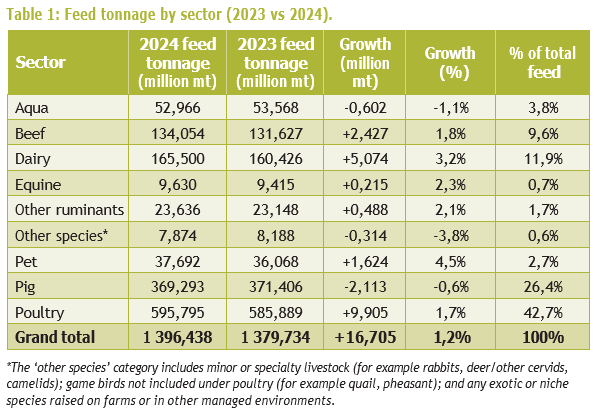
Looking at regional performance, Africa and Latin America recorded the strongest growth in global feed production. Africa grew by an impressive 7,2%, while Latin America followed with 3,6%. The Middle East saw a 2,8% increase, and Europe recorded growth of 2,7%. In contrast, feed production in the Asia-Pacific region declined by 0,8% (Table 2). This drop was mostly due to a reduction of 6,5 million mt in China’s pig feed production, driven by industry restructuring and price pressures.
Africa’s momentum is particularly important for South African feed manufacturers. Although the continent still accounts for a smaller share of global feed volumes, it recorded the highest growth rate worldwide in 2024. Some standout figures from Africa include a 32,2% increase in beef feed, a 25,7% increase in dairy feed, and a 9,1% increase in aquaculture feed.
These gains reflect the expansion of commercial livestock systems, increasing demand for animal protein, and greater investment in local food supply chains. For South Africa, this creates a strategic opportunity to serve as a regional hub for feed innovation, training, and input services.
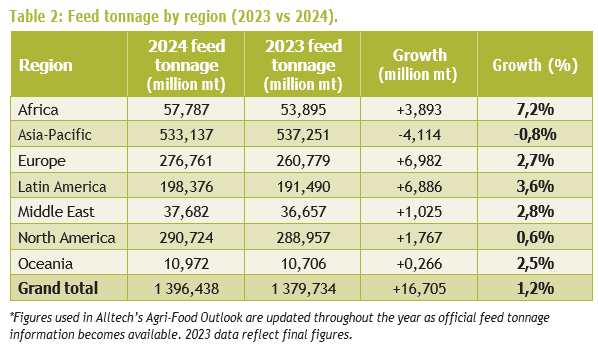
The outlook confirms that transboundary animal diseases continue to have a significant impact on global feed production. HPAI affected both broiler and layer feed volumes in 2024, with the most severe effects seen in North America, Europe, and Asia-Pacific. In the United States, HPAI outbreaks led to flock reductions resulting in a 4,2% decline in layer feed production.
Countries are responding differently. In France, authorities adopted a vaccination strategy to help reduce losses. Globally, disease remains the second most reported challenge in feed production, following input cost pressures.
African swine fever (ASF) is still affecting pig sectors in China, Vietnam, and Eastern Europe. Although some countries have started to recover, pig feed production remains very sensitive to biosecurity protocols and policy decisions. The global decline of 0,6% in pig feed may seem minor, but it reflects major regional disruptions and continued caution among producers.
For South African feed manufacturers, the message is clear. Biosecurity is no longer just a compliance matter; it is central to business continuity. Strong on-site hygiene, traceability, and proactive disease prevention are essential to reduce risk and safeguard future operations.
One of the key takeaways from the Alltech report is the growing influence of consumer affordability on feed demand. In countries facing food price inflation, especially across Asia-Pacific and Latin America, layer feed recorded strong growth as eggs remain one of the most affordable and accessible sources of animal protein.
In contrast, North America experienced a 4,2% decline in layer feed production, primarily due to the effects of HPAI.
This pattern highlights an important consideration for feed manufacturers: Protein choices are increasingly shaped by what consumers can afford. Feed formulations must therefore not only take nutritional performance into account, but also price sensitivity and market trends.
South African feed manufacturers face similar challenges, particularly with ongoing volatility in maize and soya bean prices. As inflation continues to pressure livestock and poultry producers, developing cost-effective, value-based feed solutions will be essential.
Based on feed tonnage performance and global sentiment, some key trends are expected to influence the feed sector in 2025:
Most feed manufacturers anticipate stable or improved market conditions for 2025, although this will depend heavily on managing key risks such as disease outbreaks and inflationary pressure.
South Africa’s feed industry is operating in a high-stakes environment. With variable raw material cost prices, ongoing disease threats, and shifts in regional demand, the ability to adapt will be essential. Feed manufacturers should focus on tightening biosecurity, developing cost-effective formulations, and exploring potential growth in regional African markets where demand for dairy and beef feed is rising quickly.
By Elri du Toit, intern, AFMA
Food safety encompasses the proper handling, preparation, and storage of food to prevent foodborne illnesses, which are often caused by harmful bacteria, viruses, parasites, or chemical contaminants entering the human body through contaminated food. While human food safety is widely recognised, the safety of animal feed remains an often overlooked yet essential component of the broader food safety continuum.
Ensuring the safety of animal feed is not only vital for animal health, welfare, and development, but it also directly impacts the safety of food products derived from these animals (Bastianelli and Bas, 2002). Despite becoming a routine part of operations, the critical role of feed safety in safeguarding public health is frequently underestimated. Maintaining feed safety is not only a regulatory obligation but a shared responsibility across the entire value chain.
Before the Industrial Revolution, livestock were primarily raised on small family farms, grazing on natural forage and serving as a source of food for the household (Nestel, 1984). However, the rapid urbanization and population growth triggered by the Industrial Revolution created a significant increase in demand for agricultural and animal products.
This surge in demand gave rise to the so-called ‘livestock revolution’, which marked a period of rapid advancements in animal agriculture, including the development of intensive production systems and specially formulated diets designed to enhance feed conversion efficiency and accelerate growth rates (Delgado et al., 1999).
To produce more animal products in less time, these diets began incorporating a wide range of ingredients – from plant-based products and rendered animal byproducts to antibiotics and organ arsenicals (Sapkota et al., 2007). While these innovations improved productivity, they also introduced the potential for contamination with chemical, biological, and other undesirable substances in animal feed, posing a new set of risks to human health.
A notable example that heightened global awareness of feed safety was the detection of the first American case of bovine spongiform encephalopathy (BSE) in a dairy cow (Sapkota et al., 2007). This incident underscored the critical link between animal feed and public health, prompting increased scrutiny and regulatory attention from public health authorities.
Feed plays a critical role in ensuring food safety within the farm-to-fork continuum (Sapkota et al., 2007). The use of a wide variety of raw materials in animal feed can introduce potential risks to both animal and human health if appropriate risk prevention and control measures are not implemented (Heredia and García, 2018).
For example, the well-known foodborne pathogen Salmonella can contaminate animal feed at multiple stages of the feed production process. Without adequate screening, hygiene, and preventive protocols, Salmonella can persist in feed, be consumed by animals, and subsequently contaminate animal-derived products such as eggs or meat (Heredia and García, 2018). This creates a direct pathway for the pathogen to reach consumers, posing significant public health risks.
On a global scale, internationally recognised standards – such as those developed by the International Feed Industry Federation (IFIF) and Codex Alimentarius – provide a framework that enables feed manufacturers to implement effective quality control systems, reducing the risk of hazardous substances entering the feed supply. To ensure feed safety, manufacturers are encouraged to adopt systems such as hazard analysis and critical control points (HACCP) as well as good manufacturing practices (GMP), which help identify and manage risks across the entire feed production chain.
Table 1 outlines key global frameworks and regulations that support the production of safe animal feed, ultimately protecting both animal welfare and human health.
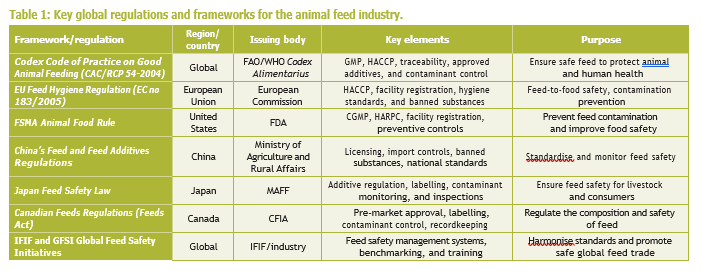
South Africa’s animal feed sector operates under strict legislation, primarily governed by the Fertilizers, Farm Feeds, Agricultural Remedies and Stock Remedies Act, 1947 (Act 36 of 1947). This Act regulates the registration, composition, and evaluation of animal feeds to ensure they meet safety and quality standards. It forms a key component of the broader food safety framework and aligns with national food safety requirements. The Animal Feed Manufacturers Association (AFMA) contributes to feed and food safety by promoting good manufacturing practices and responsible feed production among its members.
Through its Code of Conduct, AFMA encourages compliance with feed safety standards. Members who participate in the Code undergo independent audits every two years, supporting broader industry efforts to enhance feed safety and complement government oversight.
AFMA also facilitates the voluntary submission of Salmonella and polychlorinated biphenyl (PCB)/dioxin test results by its members, enabling the identification of annual and quarterly trends. This system allows for early detection of any potential rise in harmful contaminants that may pose risks to animal health, and ultimately human health.
In partnership with The Southern African Grain Laboratory (SAGL), AFMA also supports the mycotoxin monitoring project – now in its tenth year – by encouraging members to submit maize samples for mycotoxin analysis. Through these proactive initiatives, AFMA continues to strengthen feed safety and uphold public health within the food supply chain.
Global demand for animal products is projected to increase by 70% in 2025 (FAO, 2025). This growth will drive a corresponding rise in animal feed production. As a result, feed manufacturers must implement robust protocols to ensure the production of high-quality, safe animal feed – especially when scaling up throughput. Without proper controls, there is an increased risk of compromising feed safety, which can, in turn, pose threats to human health (Sapkota et al., 2007).
An additional concern is the impact of climate change, which has led to shifting weather patterns and suboptimal crop storage conditions. These changes can increase the prevalence of feed contaminants such as mycotoxins. To mitigate this risk, feed manufacturers must maintain comprehensive records of their raw material sources. The type, origin, and processing methods of these materials significantly influence the likelihood of contamination.
Feed safety is the foundation of food safety. Every stakeholder in the animal feed and livestock production chains has a responsibility to ensure that feed is safe, traceable, and sustainably produced. By investing in rigorous quality systems, adhering to best practices, and proactively managing emerging risks, we safeguard both animal and human health. Ultimately, safe feed means safe food – a shared benefit that spans the entire farm-to-fork continuum.
By Dr Lucius Phaleng, trade advisor, AFMA
Trade wars, although often rooted in specific economic or political goals, tend to have consequences that extend far beyond the initial intention. They disrupt global supply chains, raise consumer prices, and can lead to prolonged periods of economic stagnation or even conflict.
Trade restrictions may not only raise consumer prices in the short term but can also negatively affect employment, economic growth, and purchasing power in the long term. Just as trade has generated uneven distribution of welfare gains and losses across sectors, countries, producers, and consumers, the effects of trade wars are also complex.
New trade barriers imposed by the initiator of trade wars will protect or even create jobs in specific industries, but other related downstream sectors will lose due to the higher costs associated with their imported parts and intermediate goods. In addition to creating winners and losers at the domestic level, trade wars will also impact the rest of the countries that are not directly involved in them. Domestic firms in both the initiating and targeted countries in a trade war will have to quickly adjust to the new tariffs as well as other restrictive measures.
Businesses with alternative export destinations that are less dependent on intermediate inputs or raw materials from the targeted market, tend to find it easier to make the necessary adjustments to their supply chains. Regardless, trade wars will always add transaction and adjustment costs to businesses and reduce global aggregate welfare.
If two countries that engage in a trade war carry great weight in the world economy, then the trade war will not only affect the participating countries but also cause turbulence to the global economy and global supply chains. Furthermore, fewer countries may benefit from trade wars as bystanders, as they become alternative suppliers or investment destinations to the targeted country.
Global trade wars significantly impact the animal feed industry by disrupting raw grain procurement, leading to higher costs and potential shortages. Trade tariffs, restrictions, and political instability can increase the price of essential feed ingredients, affecting profitability and the cost of animal products. Most feed ingredients and raw materials are transported by sea from suppliers across the world, and sea freight is under fire due to these wars.
The escalating trade tensions between the United States (US) and China have significantly disrupted global shipping operations, with freight rates expected to surge by 30%. This has broader implications for global trade, potentially leading to increased costs for feed manufacturers that import ingredients and raw materials, and further disrupting trade routes and pricing models due to the imbalance of the global container market.
The trade wars create uncertainty about future trade policies, leading to a rise in the trade policy uncertainty (TPU) index, which negatively affects economic activities in the emerging markets and sectors reliant on international trade. The index reached a record high during the US presidential elections in November last year, and has remained exceptionally high (Figure 1) in subsequent months. The previous time the TPU index increased as strongly was during Donald Trump’s first presidential term, when trade policy tensions rose between the US and its trading partners.
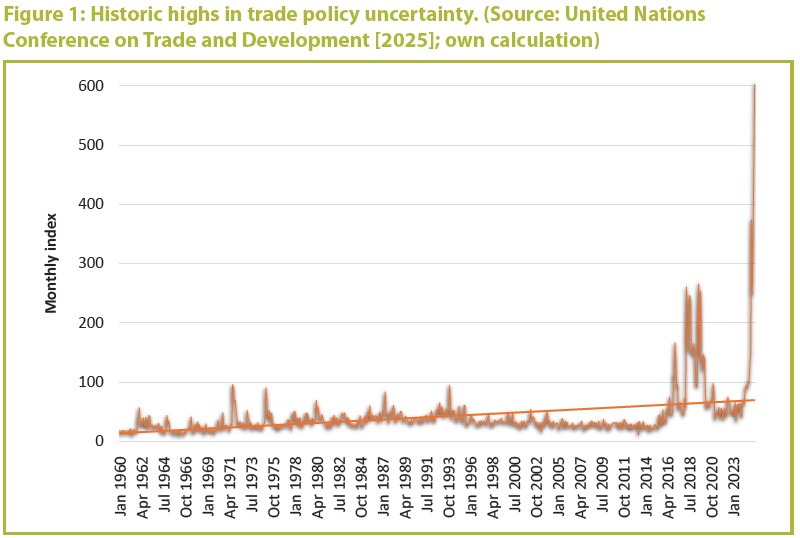
The animal feed industry depends on a wide variety of raw materials, including primary commodities such as yellow maize, soya beans, and other grains. It also utilises byproducts from processing industries, including oilseed meals, flour, germ, molasses, bagasse, and animal meal. Supplements derived from mining, such as limestone and phosphates, and chemicals such as vitamins and medicines are included in scientifically formulated feeds designed to meet the specific nutritional requirements of different animals and growth stages.
Currently, the industry is self-sufficient, with only minimal reliance on imports of raw materials and feed additives. Nonetheless, it imports various feed additives such as amino acids, enzymes, antioxidants, and growth promoters from international markets to improve feed efficiency and support animal health. According to Trade Map, Malaysia, China, and Eswatini are the primary suppliers of feed additives (harmonised system code 2309.90) to South Africa, while the US exported approximately 829 tonnes of feed additives. The imported feed additives may be affected by potential uncertainties surrounding additional tariffs and supply chain disruptions. Nevertheless, the industry is encountering increasing challenges stemming from trade wars, which have significantly disrupted various ingredient supply chains and increased trade policy uncertainty.
Such disruptions jeopardise the stability of supply chains and complicate import strategies, thereby potentially affecting the availability and cost of imported feed additives in South Africa sourced from international markets.
Global trade conflicts have significant and complex effects on South Africa’s raw grain procurement and overall market stability. The rise in trade tensions, marked by higher tariffs, restrictions, and increased policy uncertainty, disturbs international supply chains, raises costs, and threatens the availability of vital raw materials and feed additives crucial for the animal feed industry.
These disruptions increase operational expenses for local producers and pose risks to the country’s food security and economic stability. The dynamic relationship between domestic responses and global market changes highlights the importance of strategic diversification for alternative markets.
By Carin Venter
In 2020, the South African animal feed industry employed an estimated 17 000 people. This raises an intriguing question regarding the career landscape in the sector – an essential link in the feed and food chain – and opportunities for employees to grow and advance by transitioning into different roles within the industry.
Marianne van der Laarse, managing director of Agrijob and AgriCAREERConnect, recalls a time when persuading young people to pursue agricultural studies was a significant challenge. “However, emerging innovations and trends have created new career pathways, also in the livestock feed sector. We strongly encourage students to gain practical experience, as it will greatly enhance their job prospects.”
Regarding careers in the animal feed sector, Van der Laarse categorises the various roles as follows:
From Table 1 it is evident that there is a much greater demand for candidates with commercial experience.
According to Van der Laarse, the agricultural industry is facing a significant shortage of experienced professionals in marketing, trading, and procurement – particularly those with specialised scientific and product knowledge, as well as exceptional interpersonal and communication skills to effectively market and sell products or services within the sector.
“As a result, individuals who hold a BSc in Agriculture, complemented by additional qualifications in commerce, trade, management or industrial engineering, are both rare and highly sought after. This career space sits at the intersection of science and integrated technologies, equipping graduates with a diverse skill set across multiple disciplines and paving the way for a promising and resilient career trajectory.”
She advises graduates from all science-related fields, whether specialising in livestock, plants, food, microbiology, environmental science or agricultural economics, to enhance their expertise by upskilling in key interdisciplinary areas.
These include commerce, logistics, retail management, import and export, marketing and trading, industrial engineering, enterprise resource planning (ERP), electronic engineering, mechatronics, information technology, data analytics, management, and GIS technology.
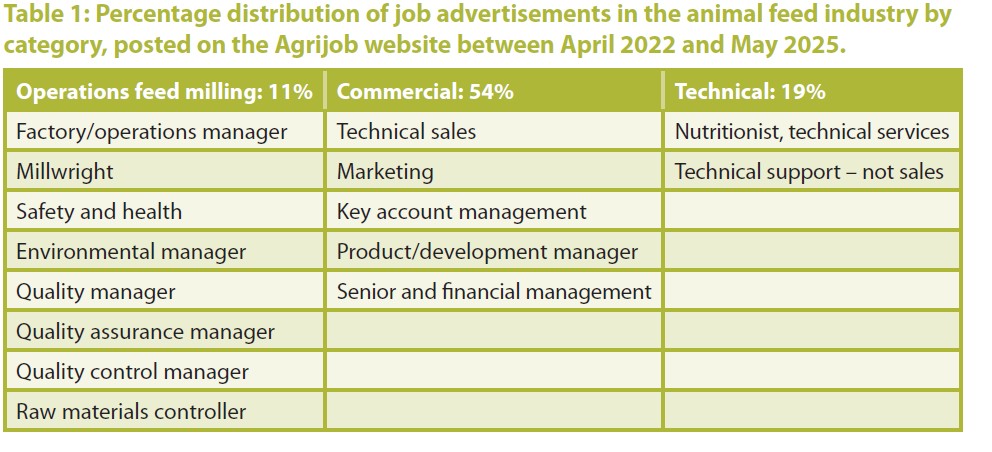
The Fresh Produce Exporters’ Forum (FPEF), in collaboration with Agrijob, provides subsidies for graduates by facilitating their placement with companies. Over the years, this initiative has enabled approximately 70% of graduates involved to secure full-time employment. However, many are later headhunted by companies offering lucrative packages – an opportunity that, while appealing, may not always be beneficial in the long run. “Young professionals who accept these offers could face challenges such as retrenchment, forcing them to seek new employment at lower compensation,” says Van der Laarse.
The agricultural sector, including the animal feeds industry, is urgently seeking to employ individuals aged 30 to 48 with strong managerial skills. Van der Laarse notes that most professionals in these roles are older, highlighting the pressing need to train younger candidates for leadership positions.
“We need career-driven men and women across all areas of the industry. It is crucial for companies to invest in young talent, and for management to actively support and empower the next generation to develop managerial expertise. Businesses should make every effort to retain these young professionals.
“An emerging trend in the animal science industry is the increasing participation of women, surpassing that of men. However, there remains significant work to be done in expanding internship opportunities within the sector. While some companies offer their own internship programmes, it would be ideal for them to maintain these initiatives annually.
This is how companies build and retain a strong workforce.”
“Due to a shortage of skilled sales staff, some companies attempt to recruit technical employees to fill these roles. While some are hesitant to make the transition, others embrace the opportunity and successfully step into these positions.”
Van der Laarse says a good example is an individual with an animal science qualification or a technical advisory background shifting into a completely different yet rewarding role such as enterprise resource planning (ERP) system management or a managerial position.
“There is significant potential for career advancement,” she notes. “Companies should recognise this within their own workforce, as retaining employees by offering growth opportunities is far more beneficial than losing them to competitors through headhunting.”
In-service training in the animal feed industry remains limited, primarily catering to students pursuing a national diploma. After having completed the theoretical component of their studies, these students must undertake six to 12 months of practical work as a prerequisite for their qualification. However, there is also a demand for basic, unskilled workers who can be trained on the job. Some of these employees excel in their roles, and companies often seek to retain them as valuable team members.
“When it comes to tertiary education and the qualifications that companies require, young professionals should think outside the box and explore integrated career paths beyond their core skill set. This forward-thinking approach is becoming increasingly relevant and will continue to shape the future of the industry. For instance, pursuing a degree in animal science, gaining hands-on experience during holidays, and remaining open to diverse career opportunities can significantly enhance their prospects.”
By Wimpie Groenewald, membership liaison officer, AFMA
In the world of feed manufacturing, success is not achieved on one’s own. It takes a well-balanced mix of people, products, and processes, all working in harmony. That is where the Animal Feed Manufacturers Association (AFMA) comes in. AFMA brings together the full spectrum of the feed value chain to build a safe, smart, and sustainable network.
Like baking a perfect cake, the feed industry depends on the right combination of core ingredients, tools, and expertise. Each AFMA member plays a vital role in this process, and together we create a resilient, future-ready industry.
AFMA membership is categorised into three distinct types, namely full, associate, and affiliate. Each membership category represents a critical element in the feed manufacturing value chain, ensuring a comprehensive and interconnected industry structure.
Full members are the primary feed manufacturers, the very heart and foundation of the industry. They produce complete and compound feeds that nourish South Africa’s livestock. Without them, the value chain would lack its central product. They are the cake itself. These manufacturers are the backbone of AFMA, ensuring that high-quality feed products reach farms across the country.
Associate members supply the critical building blocks of animal feed: raw materials, vitamins, minerals, premixes, and speciality additives. These are the quality ingredients that define the nutrition, safety, and performance of the final product. Just as no cake can be baked without flour, sugar, and eggs, no feed can be manufactured without these essential components.
Affiliate members include consultants, equipment providers, logistics companies, and other service partners. They are the tools and the know-how – ensuring that the feed manufacturing process runs efficiently, consistently, and in line with the highest standards. Without these, the ingredients remain unused and the cake unfinished.
AFMA’s membership process is designed to ensure that all members contribute meaningfully to the feed value chain while upholding the association’s commitment to industry standards and ethical conduct. The structure intentionally brings together essential industry stakeholders – from manufacturers to suppliers and service providers – creating opportunities to connect, collaborate, and contribute to a stronger, more resilient sector.
The membership process involves:
AFMA membership is automatically renewed and invoiced each year in September. AFMA members who wish not to renew their membership is subject to a notice period. The notice period for affiliate and associate members is three months, while full membership can only be cancelled by a six-month notice period.
At AFMA, we connect the cake, the ingredients, and the tools to build a robust and resilient feed value chain. By fostering collaboration between manufacturers, suppliers, and service providers, we create a network that thrives on mutual support and shared expertise.
When the right partners come together, excellence is inevitable
For more information, send an email to Wimpie Groenewald – admin@afma.co.za.
Vol 34 No 4 | October – December 2025
By Anina Hunter, chairperson, AFMA
This year, the Animal Feed Manufacturers Association (AFMA) celebrates 80 years of growth, resilience, and service to the animal feed industry in South Africa. Since our establishment, AFMA has become a central force that unites stakeholders, advances industry practices, and drives food security as we stay true to our vision: To be a dynamic thought leader in animal feed, influencing food security through partnerships with all stakeholders, and ensuring ‘safe feed for safe food’.
With the global population projected to exceed nine billion by 2050, food production must increase by at least 60%. AFMA and its members have a critical role to play in meeting this demand and ensuring that animal proteins such as poultry, beef, and pork are produced a sustainable, affordable, and safe way, while maintaining consumer trust and regulatory compliance.
We continue to build a collaborative environment that brings together academia, regulators, and producers. This network promotes knowledge sharing and evidence-based solutions that help improve practices across the feed and livestock industries. In the past year, we have strengthened partnerships across the agricultural value chain, ensuring that AFMA remains the voice of our industry.
One of our notable contributions has been evaluating the impact of the soya meal import duty, which was introduced to support local soya bean cultivation and attract investment in crushing facilities.
From importing 80% of our needs, South Africa has now become self-sufficient in producing soya bean meal – a remarkable achievement that marks one of the greatest agricultural success stories of the past decade. As the industry reaches maturity, it is time to consider whether the duty has fulfilled its purpose.
AFMA plays a key role in coordinating disease prevention efforts. Outbreaks of African swine fever, foot-and-mouth disease, and avian influenza threaten livestock health, feed demand, and national food security. Biosecurity must
remain a top priority with support from government in terms of border protection, phytosanitary regulation, and vaccine approval. Notably, South Africa recently launched its first mass vaccination of poultry against avian influenza following an announcement and approval by the minister of agriculture, John Steenhuisen.
Competitiveness and operational efficiency continue to be challenged by port delays, road and rail deterioration, and utility disruptions. These infrastructure issues require urgent attention to safeguard the long-term viability of our sector.
AFMA recognises that today’s youth are tomorrow’s industry leaders. Through educational initiatives and student engagement programmes, we are investing in the next generation of agricultural professionals – ensuring that they are equipped with the knowledge, skills, and values required to lead with impact.
As we reflect on AFMA’s 80-year legacy, we reaffirm our commitment to leading the way forward. The animal feed sector will continue to play a central role in delivering safe, sustainable, and nutritious food for a growing global population.
Thank you to our members, partners, and the AFMA team for your continued commitment and dedication to this essential industry
By Petru Fourie, Operations Manager, AFMA
Over the past 80 years, the evolution of animal feed production in South Africa, as reflected through AFMA’s feedproduction, narrates a story of steady growth, technological innovation, and adapting market dynamics. Drawn from AFMA’s historical Chairman’s Reports and industry data, this article traces the development of feed manufacturing from its modest beginnings in the 1930’s to its current status as a multi-million-tonne industry, producing over seven million tonnes annually and shaping South Africa’s livestock and poultry production and food security.
The beginning: 1930s to 1950s
The South African animal feed industry took root during the economic hardships of the 1930s. Producers, grappling with droughts and limited resources, with a turnover of approximately £120 000. The installation of electrical feed mixers during this period laid the groundwork for compound feeds.
Post-war demand for animal protein and improved farming practices drove rapid growth. Halliday’s estimates show that production surged to 250 000t by 1945 and reached 450 000t by 1954. By the mid-1950s, the need for coordinated industry representation became clear.
The newly established Association of Balanced Feed Manufacturers, which would later evolve into AFMA, issued its first comprehensive report in 1956, describing the growth as “phenomenal”. That year, production was recorded at 621 000 tonnes, with turnover exceeding £10 million.
However, this expansion was not without setbacks. Feed production declined steadily, falling to 606 000t in 1957/58, 523 000t in 1958/59, and 497 000t in 1961/62. This contraction was attributed to favourable grazing seasons, increased on-farm mixing, and reduced demand for dairy and poultry feeds.
Recovery: 1960s to early 1970s
Feed production hovered at low levels for much of the early 1960s. AFMA Chairman’s Reports indicated that almost every raw material used in balanced feeds was in free supply, making home mixing increasingly attractive to producers. At the same time, declining egg export prices reduced the profitability of poultry producers, while surplus dairy products that could not be sold at economic prices limited the demand for commercial dairy feed. These factors, combined with producers relying on on-farm feed mixing, contributed to a prolonged slowdown in commercial feed production during this period.
Production only began to recover in the latter part of the decade. By the late 1960s, the industry began to recover as mechanisation of dairies and the intensification of poultry and pig production created new demand. Feed production nearly doubled from the 1960 low to 1970, marking the start of an unprecedented growth phase.
Surge and mid-1980s decline
The early 1980s brought renewed growth driven by severe drought conditions, which increased demand for beef and sheep feed. By 1981/82, production jumped to 3,24 million tonnes, one of the most significant increases in the industry’s history. However, this surge was short-lived. The economic recession of the mid-1980s, coupled with prolonged droughts and financial pressure on livestock producers, caused feed production to drop sharply.
By 1984/85, feed production fell to 2,88 million tonnes, and by 1985/86, to 2,73 million tonnes, the lowest levels since the early 1980s. This period also saw strong price competition as feed manufacturers could no longer use a single association- recommended price list. New competition laws required each company to set its own prices, leading to greater rivalry and lower profit margins.
Recovery resumed from 1986, with production increasing. The growth was driven primarily by beef and poultry feed production, although the industry remained under economic pressure.
Restructuring and stability: 1990s
The 1990s were a period of stabilisation and market restructuring. In 1989/90, feed production increased to 3,56 million tonnes, and by 1990/91 it reached 3,89 million tonnes, with poultry feeds making up 54% of the total. Despite this growth, AFMA’s reports noted that the commercial feed industry was still supplying only around 60% of the potential market, with significant volumes being home mixed. By the early 1990s, soya bean oilcake (mostly imported at the time) had become the primary protein source in feed formulations, replacing fishmeal due to its more stable supply and cost-effectiveness compared to the volatile fishmeal market.
Throughout the decade, production fluctuated between 3,6 and 3,9 million tonnes. By 1999/2000, AFMA members broke the four million tonne barrier, producing 4,12 million tonnes despite ongoing challenges in the poultry and dairy sectors.
Expansion: 2000s
The early 2000s saw steady growth supported by improved data collection and technological advancements in feed formulation. In 2007/08, AFMA recorded a historic milestone as production surpassed five million tonnes, reaching 5,16 million tonnes, a 10% year-on-year increase despite record-high raw material prices. Poultry, which had already become the largest feed category in the 1990s, strengthened its dominance during this decade, reflecting its central role in South Africa’s protein supply.
Technological growth: 2010s
The 2010s were marked by continued growth and industry modernisation. During this decade, AFMA established monthly feed production reporting, a step that greatly enhanced transparency, improved data-driven decision-making, and positioned the industry to respond more effectively to market shifts. Advances in genetics, feed efficiency, and data management further enhanced production. During this period, the growth in layer and breeder feeds also reflected consumer trends favouring eggs and value-added poultry products, reinforcing poultry’s role as the backbone of the industry.
By 2011/12, feed output reached 6,14 million tonnes, a record at the time. Despite challenges such as droughts, avian influenza outbreaks, and volatile global soya bean prices, the industry maintained a strong upward trajectory. The decade also saw the expansion of game feed production, driven by the growth of wildlife ranching.
Volatility and resilience: 2020s
The early 2020s were marked by market volatility but also showed the industry’s resilience. Production grew steadily and in 2022/23 broke through the seven million tonne mark for the first time, reaching a new record. This was followed by weaker demand, sectoral disruptions, and the severe impact of avian influenza, which led to widespread poultry culling and reduced feed usage. While earlier outbreaks in 2017 and 2021 had highlighted the industry’s vulnerability, the 2023/24 event had the most significant impact. By 2024/25, production recovered again to just over seven million tonnes, reflecting improved market conditions as the poultry sector stabilised.
Conclusion
From 12 000 tonnes in 1939 to the current seven million tonnes, the South African animal feed industry has undergone an extraordinary transformation. Its history is marked by cycles of expansion and contraction, shaped by market forces, climatic conditions, and regulatory shifts.
Through every challenge, AFMA’s coordinated efforts, data-driven strategies, and the industry’s ability to innovate have ensured its central role in supporting South Africa’s livestock and poultry sector.
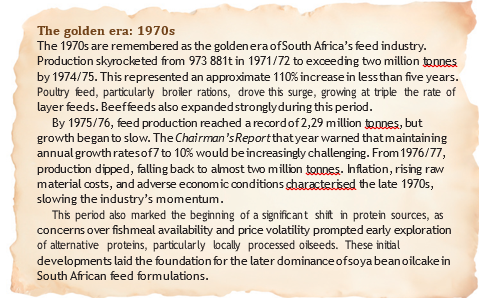
By Petru Fourie, operations manager, AFMA
For much of the mid-20th century, fishmeal was the premium protein source in South Africa’s animal feed industry. With its exceptional digestibility, high lysine and methionine content, and consistent performance benefits, it became the cornerstone of starter diets for broilers, weaner pigs, and dairy calves. In certain high-performance poultry rations, inclusion rates even exceeded 10%, a clear sign of its value and the confidence the industry placed in it.
Over time, however, fishmeal’s dominance waned. Rising costs, inconsistent supply, and growing sustainability concerns opened the door for plant-based proteins such as soya bean and sunflower oilcake. This transition reshaped feed formulations and fundamentally shifted how the industry approached protein sourcing and long-term sustainability.
From by-product to protein (1940s to 1960s)
The commercial production of fishmeal in South Africa began in the 1940s, spurred by the growth of coastal fisheries along the West Coast. Offal from anchovy and pilchard processing, once discarded as waste, was transformed into high-protein meal at plants in Saldanha, Hout Bay, and Walvis Bay.
By the 1950s, fishmeal was considered the premium protein source. It boosted feed conversion ratios, supported rapid growth in young animals, and delivered consistency across rations. During this period, AFMA committees actively discussed fishmeal imports from South West Africa and Peru, while also raising early concerns about the need for standardised quality control protocols.
While fishmeal was celebrated for its nutritional excellence, even at this early stage concerns emerged: price volatility, seasonal availability, and quality inconsistencies foreshadowed future vulnerabilities.
The height of fishmeal use (1970s to 1980s)
The 1970s ushered in the golden age of fishmeal in South Africa. During this period, the country exported fishmeal to Europe and Asia, while still meeting strong domestic demand. Poultry starter diets frequently included 10 to 12% fishmeal, and it featured prominently in rations for dairy calves and piglets. With domestic animal production booming, fishmeal was both affordable and abundant. It offered critical nutrients such as lysine, methionine, and calcium, vital in supporting early growth stages and reproductive performance.
Minutes from AFMA technical and executive committee meetings in the late 1970s repeatedly started to highlight member frustration over sudden fishmeal price surges and allocation inconsistencies, as export prioritisation during high-price cycles further tightened local supply.
Chairman’s Reports from this era frequently stressed the need for stricter quality standards and improved supply security.
During severe shortages between 1983 and 1984, AFMA even proposed establishing a fishmeal importation company to stabilise supply, highlighting the strategic importance of fishmeal at the time.
Shifting tides: The 1990s
By the 1990s, fishmeal’s dominance waned under mounting pressures: stricter environmental controls on processing plants, tighter marine quotas introduced later in the decade, and rising global competition from markets such as China and Europe.
AFMA members began reformulating broiler diets to reduce or exclude fishmeal, aided by synthetic amino acids that allowed plant proteins to match its performance. This shift paved the way for soya bean oilcake, supported by imports from Argentina and Brazil and the gradual expansion of local crushing capacity.
AFMA’s technical committees compared cost-performance models for oilcake- based diets, while tariff debates and calls for import rebates highlighted the need to secure affordable protein supplies.
Turnaround: 2000s to 2010s
The early 2000s marked a turning point for the feed industry, as aflatoxin contamination in groundnut oilcake heightened the need for safer, more consistent protein alternatives. Fishmeal, while still a high-quality ingredient, had become costly and its availability increasingly erratic due to global demand and marine resource constraints, discouraging its use in standard formulations.
By the 2010s, fishmeal’s role in mainstream commercial feed had fallen to trace levels, confined mainly to specialised applications, high-end pet foods, and select breeder rations that required top-tier nutrition. In contrast, soya bean oilcake rose rapidly, driven by local investments in crushing plants and supported by genetically modified (GMO) soya bean varieties that improved both supply stability and protein consistency.
Soya bean oilcake: More than a substitute
The rise of soya bean oilcake was not merely a response to fishmeal’s decline; it marked a structural shift in South Africa’s protein sourcing. Initially reliant on imports, the feed industry soon recognised the value of expanded domestic crushing capacity, which stabilised supply and reduced dependency on volatile imports. Combined with advances in synthetic amino acids and enzymes, soya bean oilcake became the cornerstone of modern feed formulations.
Legacy and lessons
The decline of fishmeal was more than an ingredient change; it forced the industry to innovate, diversify, and embrace sustainability. Synthetic amino acids allowed plant proteins to deliver performance on par with animal-derived ingredients. Today, soya bean oilcake is firmly entrenched as a foundational ingredient, not a fallback. Its rise reflects AFMA’s pivotal role in helping the feed industry navigate transitions while maintaining both nutritional performance and economic resilience.
Conclusion
What began as a discarded by-product of the fishing industry evolved into a pillar of animal nutrition, only to be overtaken by soya bean oilcake in a new era defined by precision and sustainability. From lobbying for quality standards to shaping trade discussions and supporting local value chain development, AFMA played a crucial part in this transformation.
As AFMA marks 80 years, the journey from ocean to oilcake stands as a testament to the industry’s innovation, collaboration, and resilience.
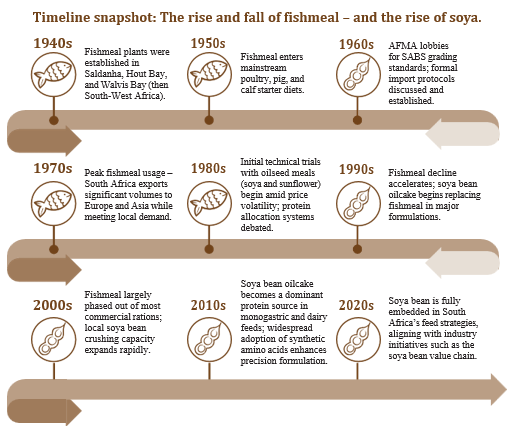
By Wimpie Groenewald, member liaison officer, AFMA
From its humble beginnings in the 1930s, marked by the installation of South Africa’s first five-tonne electric feed mixer, the country’s animal feed industry began its journey towards structured organisation and professionalisation.
In 1945, the establishment of the Association of Balanced Feed Manufacturers marked the industry’s first formal step towards collective representation. Two years later, in 1947, the Association hosted its first annual general meeting, setting the stage for what would later become the Animal Feed Manufacturers Association (AFMA), the recognised voice of Southern Africa’s feed industry.
Expansion and consolidation
By 1956, AFMA’s predecessor had achieved significant growth, adding eight new members and approaching full representation of the national feed industry. By 1957, the Association had 47 full members covering approximately 99% of South Africa’s feed tonnage, a level of consolidation rare in the sector at the time. Membership remained stable through 1958.
However, the early 1960s saw fluctuating numbers. Membership fell to 30 full members in 1961, though associate membership was recorded for the first time. A shift towards industry-defined standards emerged in 1965, as the Association moved away from reliance on the SABS Bureau Mark, signalling the start of independent self-regulation.
In 1962, with the move to a more independent office space and a new membership fee structure (R10,50 per member plus a levy of ½ cent per tonne of feed), the organisation laid the groundwork for a more predictable revenue model and professionalised membership administration. This step allowed AFMA to expand its services and deepen its technical engagement, drawing more feed companies into the fold.
In 1976, rising member concerns regarding voting fairness and representation led to the formation of AFMA’s first constitutional subcommittee and costing standards committee – one of the Association’s earliest governance reforms.
By 1980, membership had rebounded strongly to 61 full members from 35 recorded a decade earlier. This growth was solidified in 1983 when AFMA reached 68 members, representing 94% of national feed sales.
A key development in the 1980s was the formalisation of associate membership, allowing suppliers, equipment providers, and non-manufacturing stakeholders to participate in the AFMA ecosystem. This diversification was important for broadening AFMA’s influence across the value chain.
Yet, by 1986, membership declined slightly to 50 full members, prompting structural and ethical reforms related to pricing practices, constitutional alignment, and emerging competition legislation.
Compliance and diversification
In the early 2000s, AFMA formalised its compliance framework, culminating in the 2006 registration of its ‘Safe Feed for Safe Food’ trademark. A major milestone followed in 2008 when compliance with the CoC became mandatory for all members. Meadow Feeds became the first full member to comply, followed by Ceva Animal Health as the first associate member in 2009.
These achievements underscored AFMA’s leadership in food safety and regulatory enforcement.
Between 2008 and 2015, the CoC evolved into AFMA’s core standard, supported by audit protocols, transport standards, and traceability systems.
This period also saw rapid membership growth, particularly among associate members (reaching 82 by 2015) as the organisation welcomed traders, service providers, and premix suppliers.
By 2011, AFMA had expanded its focus to include industry training and accreditation, offering members access to technical workshops, global symposiums, and formal feed miller qualifications, reinforcing its role as both a regulatory and professional development leader.
Regional leadership
By 2015, AFMA had extended its influence beyond South African borders, collaborating in the establishment of regional industry bodies such as the Southern Africa Feed Manufacturers Association (SAFMA) and the Tanzania Feed Manufacturers Association (TAFMA). This regional expansion was complemented by increased collaboration with agricultural and food safety institutions across Southern Africa.
In 2018, AFMA supported the formation of the Zambian Animal Feed Manufacturers Association (ZAFMA), modelled on AFMA’s governance principles. This initiative, along with mentorship of the Association Kenya Feed Manufacturers (AKEFEMA), further positioned AFMA as a leader in regional industry development.
Adaptation and structures
Despite pandemic-related disruptions in 2020, AFMA maintained regional engagements while innovating its compliance systems. By mid-2021, audits resumed, expanded to a 12-point system, and pre- screening phases were introduced to enhance audit rigor.
By 2025, AFMA had introduced remote audits for traders without warehousing and for manufacturers located in Southern African Development Community (SADC) countries not exporting into South Africa – a pragmatic step towards embracing modern inspection methods while expanding membership inclusivity.
During this time, AFMA also formalised warehouse audits and off-site storage inspections, ensuring all members upheld exacting standards of traceability and feed safety – regardless of their operational footprint
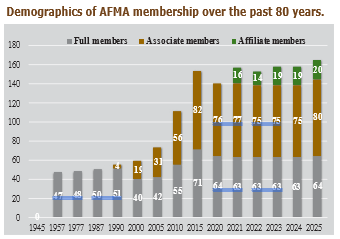
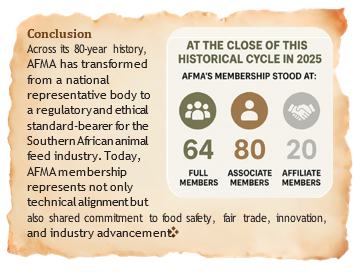
Since its founding, AFMA has championed the professionalisation and ethical development of the animal feed sector in Southern Africa. Central to this mission has been the creation of the AFMA Code of Conduct (CoC), a framework that has evolved from informal ethical agreements into one of the continent’s most robust, auditable self-regulatory systems.
As the industry matured, so too has the CoC, adapting to emerging risks, technological changes, and global standards. This article traces the remarkable journey of the CoC, showcasing how AFMA has institutionalised accountability while promoting trust, safety, and international alignment across the feed value chain.
Laying the groundwork
AFMA’s commitment to ethical practices began long before formal compliance systems were the norm. In the 1960s, then operating as the Association of Balanced Feed Manufacturers, AFMA spearheaded the push for the specifications of poultry feed under South African Bureau of Standards (SABS) standardisation and discouraged unregulated home-mixing.
A defining moment came in 1965 when members voluntarily withdrew from using the SABS bureau mark, signalling a collective confidence in self-regulation.
By the 1970s, industry concerns around pricing transparency and governance catalysed the formation of AFMA’s first constitutional and costing subcommittees. These laid the groundwork for modern compliance, establishing early systems of accountability and procedural integrity. In 1976 AFMA drafted its first Code of Practice (COP) for feed manufacturing, marking the beginning of formal self-regulation and a commitment to quality. The year 1981 earmarked the refinement of the draft COP into a more detailed framework covering production hygiene, ingredient integrity, and formulation practices.
Codification and formalisation
The 1990s marked the transition from ethical norms to formalised standards. In 1992, AFMA introduced its first internal CoC, targeting hygiene risks such as poultry litter in feed. Although unpublished, this set a critical precedent for future safety and hygiene benchmarks. That same year, AFMA launched AFMA Matrix, a quarterly publication that remains instrumental in disseminating best practices and compliance updates to this day.
A landmark achievement followed in 1994 with the adoption of a COP for Salmonella control, modelled after European Feed Manufacturers’ Federation guidelines. By 1996, the COP had formalised feed hygiene and risk management practices. Concurrently, AFMA began drafting a good manufacturing practices (GMP) code, shifting focus from product registration under Act 36 of 1947 to facility- level quality control. The draft, submitted to the Registrar in 1999, would become a precursor to today’s compliance framework.
Voluntary to mandatory compliance
The turn of the millennium ushered in a new era for AFMA. In 2004, the Board approved the development of a formal, auditable CoC. A year later, the first official draft was released, coinciding with rising global concern over feed safety, traceability, and consumer protection.
In 2006, AFMA registered its iconic slogan Safe Feed for Safe Food and by 2008, compliance with the CoC became mandatory for all members. This landmark policy shift marked the transition from voluntary ethics to enforceable standards. Independent audits were initiated through Afri Compliance, using a rigorous nine-point audit framework.
Meadow Feeds became the first full member to meet all requirements, with Ceva Animal Health following as the first associate member in 2009. This era also laid the groundwork for structured enforcement, membership accountability, and continuous improvement through third-party evaluation.
Regional integration
Between 2010 and 2025, AFMA’s CoC evolved into a mature, regionally recognised, and digitally enabled compliance system. The audit framework expanded to ten points in 2010, incorporating transport standards for biosecurity and traceability, and by 2014 most members had completed their third audit cycle. Regional recognition followed, with Meaders Feeds becoming the first Southern African Development Community (SADC)-compliant member in 2011 and AFMA collaborating with the Southern African Feed Manufacturers Association (SAFMA) and SADC initiatives by 2015.
From 2016 onward, AFMA assumed full responsibility for the audit process, rolling out the system in phased stages, boosting efficiency and transparency. The CoC inspired regional adoption, including the Zambian Animal Feed Manufacturers Association (ZAFMA) in 2018 and Association Kenya Feed Manufacturers (AKEFEMA) in 2020. After a brief Covid-19 pause, audits resumed in 2021 with a 12-point audit framework, pre-audit screening, and full in-house administration.
To strengthen oversight, AFMA introduced affiliate membership and warehouse audits in 2022 and, by 2025, remote audits for SADC-based traders and facilities. These innovations reflect a maturing, adaptable system that supports both local and regional feed industry accountability.
Modernising for the future
The CoC is now in Phase 3 of a major modernisation initiative. Focus areas include benchmarking the Code against the 2021 audit criteria, pilot testing, assessment body expansion, and implementation. One of AFMA’s most critical priorities is expanding the pool of accredited assessment bodies. While Afri Compliance remains the sole provider, various additional certification bodies currently used by members are under review. All providers will use a unified AFMA audit template to ensure consistent application across the board.
Certification benchmarking
A member survey conducted in early 2025 revealed that 57% of AFMA members – including 65% of associate members and 48% of full members – operate without formal certifications such as hazard analysis and critical control points (HACCP), GMP, or International Organization for Standardization (ISO). Instead, they rely exclusively on the AFMA CoC as their primary quality system.
To ensure global alignment while maintaining local practicality, the code was benchmarked across four dimensions:
Based on the findings, AFMA is in the process of revising the 2021 version of the CoC audit manual and audit sheets to ensure a fit-for-purpose model that balances rigour with applicability for South African operations.
A tiered compliance model is currently under development. Aligned with ISO 22000 and global feed codes, this approach scales compliance requirements based on a facility’s size and operational complexity, while maintaining integrity. This model is aimed to provide a clear entry point for smaller operators and a comprehensive structure for larger operations.
Legislation and recognition
The updated code is expected to play a critical role under South Africa’s upcoming Feeds Bill, where facility licencing will be required. Interestingly, the code is also gaining traction as a pre-approval standard in sectors such as dairy. AFMA will continue to advocate for its formal recognition in national compliance trends and continuous improvement.
AFMA requires all full and associate members to undergo audits every two years. Since June 2023, 12% of audited facilities were found non-compliant. Issues included improper labelling, unregistered raw materials, absence of South African Council for Natural Scientific Professions (SACNASP) nutritionists, hygiene lapses, biosecurity gaps, and regulatory non-conformance.
These insights are used to inform training initiatives, future audit revisions, and targeted member support, ensuring continuous improvement across the industry.
A living system
The AFMA CoC is not a once-off achievement – it is a living system. It reflects the evolution of the industry, adapts to new risks, and embodies the values of science, transparency, and shared responsibility. As South Africa’s feed sector continues to grow and diversify, the Code remains central to AFMA’s mission: promoting Safe Feed for Safe Food while building a trusted, self-regulated, and globally competitive industry.
In its 80th year, AFMA looks forward with pride and purpose.
The CoC is more than a compliance framework – it is the embodiment of the industry’s integrity. And as we innovate, adapt, and lead, it will continue to serve as the foundation of trust across the entire feed value chain.
COC timeline:
1960s to 1980s: Laying the groundwork
1990s: Codification and formalisation
2000s: From voluntary to mandatory compliance
2010 to 2025: Maturity, transformation, and regional integration
2025 and beyond: Phase 3 modernisation
By Dr Lucius Phaleng, trade advisor, AFMA
The South African Futures Exchange (Safex) is the futures exchange subsidiary of the Johannesburg Stock Exchange or JSE. Safex was formed in 1990 as an independent exchange and experienced steady growth over the following decade.
In 1995, a separate agricultural markets division was formed for the trading of agricultural derivatives. The exchange continued to make steady progress despite intensifying competition from international derivatives exchanges and over-the-counter markets, where contracts are traded privately rather than through a centralised exchange.
The JSE Commodity Derivatives Market provides a platform for price discovery and efficient price risk management for the grains markets in South Africa. Through a licencing agreement with the CME Group – the world’s leading derivatives marketplace – the market also offers a range of foreign- referenced derivatives on both soft and hard commodities. The use of derivative instruments through futures and options contracts provides market participants with the ability to manage their price risk in the underlying physical markets.
Futures contracts traded
By trading on a formal exchange that connects buyers and sellers, not only is price discovery achieved transparently, but all transactions are guaranteed through the derivatives clearing structure. The physically settled commodities rely on warehouse receipts (WRs) to facilitate the delivery process. The WRs are used by financial institutions that offer financing to clients who own receipts.
Derivative contracts also enable institutions to fund input costs to producers who hedge their price risk and, in so doing, encourage sustainable production. The JSE currently offers futures and options on white maize, yellow maize, wheat, sorghum, and soya beans.
Contracts are priced and traded in rands/t and can be physically settled should the futures position be held until the last trading day.
Other trading platforms, such as CME Group, offer a diverse range of agricultural futures markets (such as maize, soya beans, soya oilcake, wheat, oats, rice, coffee, cocoa, sugar, orange juice, and milk), allowing traders and producers to hedge and speculate on the prices of various commodities.
These futures contracts are traded on the CME Globex electronic trading platform and are used by market participants worldwide for risk management, price discovery, and investment purposes.
CME Group’s Chicago Board of Trade (CBOT) launched its first soya futures contracts on 17 October 1951. This was part of the broader development of agricultural futures markets at CBOT, which included soya beans and soya bean oil. However, the JSE has yet to introduce soya oilcake futures contracts, despite market demand expressed by the animal feed industry.
Facilitating risk management
The potential soya oilcake futures contracts will allow feed manufacturers, importers, and the local oilseed crushing role-players the opportunity to use the product in price risk management strategies. This facilitates risk management by allowing animal feed manufacturers to hedge against price volatility in soya oilcake, which is a key ingredient in animal feed. Additionally, the futures market enhances market liquidity, making it easier for stakeholders to buy and sell positions without significant price impacts. The increased transparency and access to hedging tools ultimately lead to more stable feed prices.
Overall, the Safex listing empowers the animal feed industry with improved market efficiency, risk mitigation options, and price stability, fostering growth and resilience within the sector
Vol 35 No 1 | January – March 2026
By Liesl Breytenbach, Executive Director, AFMA
Each new year inevitably brings renewed energy and a sharpened sense of purpose. I trust that our members and industry partners have had the chance to rest and reconnect over the festive season. As we enter 2026, the feed industry finds itself at a defining moment. The Animal Feed Manufacturers Association (AFMA) will approach this year with clarity, resolve, and a firm conviction: The feed sector is not only adapting to change – it is shaping the future of South Africa’s agricultural and food value chain. AFMA Matrix has long served as AFMA’s voice: a bridge between science and industry, between policy decisions and practical implications. It is more than a publication – it is the sector’s narrative backbone. During 2025, AFMA refined the editorial direction of AFMA Matrix to ensure that each edition delivers targeted, sector-specific analysis that reflects the realities, opportunities, and innovations across South Africa’s feed-to food system. Members can expect even stronger insights from experts across trade, regulation, production, and infrastructure. Opportunity across the value chain. This first issue of 2026 reflects that renewed strategic intent to inform, connect, and inspire. It carries a central message for the feed and livestock industries: within challenges lie opportunities. After several difficult years, the poultry sector is demonstrating early signs of recovery. Continued improvements in disease control of highly pathogenic avian influenza (HPAI), biosecurity systems, and trade protection, underpinned by policy alignment, will be essential as phase two of the Poultry Masterplan advances. For the feed sector, this recovery reinforces the critical importance of efficiency, cost management, and innovation as drivers of national food security and competitiveness. Across the broader livestock value chain, cautious optimism is emerging. Softer feed prices, supported by higher soya bean production and stabilising market conditions, are creating space for improved performance, particularly in intensive production systems. Nonetheless, persistent challenges in disease management of foot-and mouth disease (FMD) and African swine fever (ASF), infrastructure reliability, and constrained consumer spending will influence the pace of growth. These are precisely the areas where the feed sector’s technical expertise from formulation to safety, quality assurance, and biosecurity continues to deliver tangible value.
Driving sustainable progress
As the industry evolves, attention must now shift decisively to the regulatory environment that governs agricultural inputs. The modernisation of the Fertilizers, Farm Feeds, Agricultural Remedies and Stock Remedies Act, 1947 (Act 36 of 1947) remains a priority area for collaboration between government and industry. The transition towards electronic submission systems, more effective oversight, and formal recognition of existing compliance initiatives across the feed and livestock sectors will collectively strengthen South Africa’s food production system. Logistics reform is equally pivotal. Rail and port performance continues to influence the reliability and affordability of feed ingredient supply. The revitalisation of Transnet and parallel logistics reforms will play a defining role in determining the sector’s growth trajectory over the coming years. Across all these themes, sustainability emerges as the unifying principle. Through engagement with the International Feed Industry Federation (IFIF) and Food an Agriculture Organization (FAO), AFMA has seen how global thinking has matured: Sustainability is no longer confined to environmental outcomes but extends to economic resilience, food safety, and social responsibility. For AFMA, sustainability is a practical, daily commitment ensuring that every tonne of feed produced contributes to a stronger, safer, and more efficient food system. Leading with purpose The articles in this issue underline a powerful reality, namely that the strength of the feed industry lies in its connectivity to primary producers, policy and regulation, trade and logistics systems, and global markets. It is an industry grounded in science, collaboration, and resilience, and one that continues to adapt to ensure South Africa’s agricultural future is competitive and secure. This year marks a new chapter for AFMA and the industry we serve. The challenges ahead require collaboration and innovation but they also offer a significant opportunity to reimagine the role of feed manufacturing in shaping a sustainable and inclusive food system for South Africa. AFMA’s vision for 2026 is to lead with purpose and to ensure our members are equipped with current information and the insights and confidence to act decisively. AFMA Matrix will continue to evolve as the industry’s trusted knowledge platform, reflecting both the technical depth and the forward-looking ambition that define our community. This year will undoubtedly bring challenges, but also unprecedented opportunity. Let’s meet them with courage and collaboration, knowing that our collective efforts strengthen not only the feed industry, but the broader food system that nourishes the nation.
By Susan Marais, Plaas Media
Wiana Louw is a stalwart in the South African grain value chain. From seed to feed, it would be difficult to find any segment untouched by her influence.
Although she will retire as general manager of the Southern African Grain Laboratory (SAGL) at the end of September this year, Wiana has no intention of settling into a typical pensioner’s life. In fact, simply writing these words feels as absurd to me as it will to anyone who knows her! Instead, she sees retirement as a launchpad for renewed innovation. As we sit in her office, sipping coffee, this becomes unmistakably clear. Wiana still speaks about her work with the enthusiasm of an eager intern discovering a world of possibilities – yet she carries the wisdom that comes only from decades spent at the coalface. Doing the best with the best. Over nearly 17 years at the SAGL, Wiana has witnessed remarkable developments and collaborated with exceptional people. “I have been very privileged to work with some of the best in the industry during the peak of their careers,” she says, adding that the role is any scientist’s dream because the SAGL is the link between academia and real world application. The laboratory’s work has also provided researchers with ample opportunities to advance their own careers through meaningful, industry benefitting research. One example is the PhD study by researcher Theresa de Beer, focussed on what has been dubbed ‘paprheology’. If the term is new to you, don’t worry – it was coined at the SAGL to describe this unique study. “Rheology refers to the study of dough quality, and Theresa is investigating the quality of pap, or cooked maize meal. So, we combined the two and came up with ‘paprheology’,” Wiana explains. “The rest of the world doesn’t cook and eat pap the way we do in Southern Africa, and people often underestimate how sophisticated our maize milling industry truly is. International visitors are always amazed when they encounter it.” Theresa’s research focusses specifically on methods to measure the stickiness of pap. It is also one of the reasons why Wiana wants to remain involved. Her scientific curiosity is far from satisfied. The vision continues The SAGL was born from the laboratories of the former Wheat and Maize Boards. In those early years, the laboratories performed basic tasks such as crop surveys and small-scale research for millers. Times have changed, however, and if Wiana has her way, they will continue to evolve. Her dream is for the laboratory to transform into a one-stop hub where every part of the industry can find answers to most, if not all, of their crop survey, grain measurement, and grain-related scientific questions. After all, scaling up is key to any laboratory’s longterm sustainability. “Many labs in other sectors are somewhat removed from the industries they serve. Yet we are right in the middle of the action, and it is wonderful to be here. It is great to truly be part of the value chain,” Wiana remarks. This proximity, she adds, gives the SAGL a unique advantage in understanding exactly what the industry aims to acheive.
One of the major issues Wiana hopes to focus on once she is ‘retired’ and has more time, is investing in people – both within the SAGL and across the broader industry. “People truly are your biggest asset, and it is critical for us to retain human capital as best as possible. To achieve this, we must ensure that our people feel safe and empowered.”To strengthen human-capital development even further, Wiana envisions helping to establish a training centre for grain monitoring and measurement scientists – a facility that could serve multiple industry bodies and companies beyond the SAGL. “There’s a lot of training happening across the grain and oilseed value chain, and there might even be room for consolidation.” Risk monitoring She also believes the SAGL may one day be well positioned to apply as an assignee of the Department of Agriculture. “If ever we are in such a position, I think it would be wise to start with a risk assessment of the industry and focus on the greatest risks first. You don’t have to be perfect from the outset, but you do need to start somewhere.” A potential starting point for monitoring risk in South Africa’s grain industry could be auditing the dry-matter content of bread. “Begin by reviewing companies’ records, identify gaps, and use that as your foundation,” she advises. Among her many career highlights is the establishment of the Crop Protection Division, which brought that part of the grain and oilseed value chain closer to the mainstream. Ultimately, there are countless research opportunities across the value chain that remain unexplored and Wiana believes the SAGL is ideally positioned to pursue them. Rooted in research Wiana is an educator at heart. She holds a Higher Education Diploma in Natural Sciences (now BSc Ed) from the University of the Free State, where she majored in botany, zoology, and chemistry. This academic foundation set the stage for her lifelong dedication to training, scientific rigour, and public health through food safety and regulatory compliance. Her professional journey began at Roodeplaat Research Laboratories (1988 to 1993) where she coordinated the National Residue Monitoring Programme. Her work centred on detecting pesticide and veterinary drug residues in animal derived products to ensure food safety and regulatory compliance. During this time, she played a key role in developing and validating analytical methods, as well as implementing quality management systems that led to achieving laboratory accreditation. She also demonstrated ethical leadership through her service on the institutional ethics committee. From 1993 to 1998, at the South African Bureau of Standards (SABS), Wiana continued her work in residue analysis, supporting product registration and monitoring. She was instrumental in securing ISO/IEC 17025 accreditation and OECD Good Laboratory Practice (GLP) compliance while mentoring new analysts and strengthening internal quality systems. Her tenure at the Council for Scientific and Industrial Research (CSIR) from 1998 to 2003 marked further expansion in pesticide and mycotoxin method development, and laboratory capacity building. She led cross functional projects and contributed to pharmaceutical research involving indigenous plant materials, effectively bridging traditional knowledge with contemporary scientific approaches. Wiana returned to the SABS from 2003 to 2009 to lead the Chromatographic Services Department. In this role, she oversaw pesticide and veterinary drug registration and residue monitoring activities, fortifying analytical capabilities and helping the agricultural sector meet both local and international standards. Wiana served at the SAGL from 2009, where she did some of her most impactful work. She established the National Mycotoxin Monitoring Programme, generating essential data to inform regulatory updates and underpin feed safety. The Crop Protection Division provides GLP-compliant services for plant protection product registration. Her contributions have extended into academia through support for tertiary institutions, internships, and pathways for postgraduate research and development.
Recognition and engagement Wiana’s contributions have been recognised through several accolades, notably her selection as a finalist in the 2017 Standard Bank Top Woman Awards and her nomination for the 2025 National Science and Technology Forum Management Award. Her influence spans a wide range of industry platforms. She serves on technical committees for agricultural trusts, the Animal Feed Manufacturers Association, Agbiz Grain, the National Chamber of Milling, and the South African Chamber of Baking. In these capacities, she has helped shape quality control systems and supported regulatory authorities through public-private partnerships that generate and interpret technical data for policy development. Wiana’s legacy is characterised by her unwavering commitment to innovation, capacity building, and regulatory excellence. Her leadership has elevated South Africa’s competitiveness in meeting international compliance standards, particularly in feed safety and analytical science. She has mentored numerous young scientists, championed skills development, and built strong collaborative bridges between academia and industry.
By Bonita Cilliers, technical and regulatory advisor, AFMA
Antimicrobial resistance (AMR) has become one of the defining global health and food security challenges of our era. Once hailed as the cornerstone of medical and veterinary progress, antimicrobials are losing their effectiveness as bacteria adapt and evolve faster than the development of new medicine. The scale of the crisis is staggering. According to the World Health Organization or WHO (2023), bacterial AMR was the direct cause of 1,27 million deaths in 2019 and contributed to almost five million additional deaths worldwide that same year. The World Bank warns that by 2030 AMR could cost the global economy up to US$3,4 trillion annually in lost productivity. Resistant pathogens move between people, animals, the environment and food, and demand a unified One Health response that connects human, animal, and environmental wellbeing. Under the leadership of the Quadripartite Alliance – comprising the Food and Agriculture Organization (FAO), World Organisation for Animal Health (WOAH), United Nations Environment Programme (UNEP), and WHO – the forthcoming Global Action Plan on AMR (2025 2035) calls for renewed global commitment to prevention, focussing on hospitals and the entire agri-food chain. Within this framework, the feed and livestock sectors play a decisive role. Preventing disease before it occurs through sound husbandry, biosecurity, and scientifically balanced nutrition is no longer optional; it is essential for safeguarding animal productivity, public health, and the long-term effectiveness of antimicrobials.
From use to stewardship
For more than 70 years, antimicrobials have supported livestock production by improving health, growth, and feed efficiency. When used responsibly and under veterinary guidance, they remain an indispensable tool for animal welfare and food safety. However, the misuse and overuse of these medicines, particularly at non therapeutic doses or without appropriate oversight, have contributed to the development and spread of AMR. The United States Food and Drug Administration’s Guidance for Industry no 72 (2023) and the WHO’s Critically Important Antimicrobials for Human Medicine (2022) both reinforce a central principle – stewardship, not prohibition. Medically important antimicrobials must be used only when necessary, under professional supervision, and for clearly defined therapeutic or preventive purposes. In animal nutrition, this stewardship mindset is rapidly gaining ground. The focus has shifted from dependency on antimicrobials towards holistic health, using high-quality feed, improved management, and nutritional innovation to reduce disease risk. The principle is clear: A healthy, well-fed animal is naturally more resilient and less reliant on antimicrobial intervention.
Global evidence
Research continues to map the uneven global burden of resistance. A study by Van Boeckel et al. (Science, 2019) identified AMR ‘hotspots’ across China, India, Pakistan, Brazil, Egypt, and Southern Africa – regions where livestock production is intensifying but feed quality and oversight remain inconsistent. Resistance to common antibiotics such as tetracyclines, sulphonamides, and penicillin already exceeds 40% in pigs and poultry in several of these regions. The findings underscore a simple but powerful truth: prevention must come before treatment. Vaccination, veterinary oversight, hygiene, and biosecurity remain indispensable, but nutrition has now been recognised as an equally vital pillar of prevention. The FAO, EFSA EMA (2017), and the Quadripartite Alliance all highlight that adequate animal nutrition improves gut health, immunity, and overall resilience, hence reducing the need for antimicrobials while maintaining productivity and welfare.
IFIF’s global leadership
Representing over Representing over 80% of global compound feed production, the International Feed Industry Federation (IFIF) has become a leading advocate for integrating nutrition into the global AMR response. Its flagship programme, Nutritional Innovation to Promote Animal Health and Welfare, provides a scientific and regulatory framework demonstrating how balanced feeding supports animal resilience and antimicrobial stewardship, particularly in low- and middle-income countries. The IFIF framework is built on three interlinked pillars:
• Scientific validation: Demonstrating measurable benefits of quality feed on gut integrity, immunity, and resilience.
• Regulatory clarity: Using the Delineation Approach (2023) to distinguish nutritional solutions from veterinary drugs and prevent over-regulation.
• Capacity building: Empowering national feed associations to advocate for nutrition as a recognised prevention tool.
Through collaboration with the FAO, WOAH, and Codex Alimentarius, IFIF ensures that advances in feed science are reflected in One Health dialogues, which bridge science and policy to promote preventive, sustainable animal health systems. Despite the growing evidence, regulatory recognition remains limited. The IFIF Regulatory Report (2020) notes that most national frameworks still treat feed mainly as a compositional or safety issue, while its health supporting functions often fall between veterinary and feed legislation. To close this gap, IFIF and the FAO recommend establishing harmonised criteria for nutritional health claims; recognising nutrition as an evidence-based resilience tool within AMR policy; and encouraging joint assessment mechanisms between feed and veterinary authorities.
Feeding for health
IFIF defines adequate nutrition as: “The oral intake by animals of adequate levels of nutrients, substances, microorganisms, and other feed constituents, considering their combination and presentation, necessary to fulfil functions related to their physiological states, including the expression of most normal behaviour, and their resilience capabilities to cope with stressors of various types encountered in appropriate husbandry conditions.” In practice, this means optimising feed composition, processing, and feed presentation; minimising exposure to feed borne contaminants such as mycotoxins; meeting nutritional needs for maintenance, growth, reproduction, and immunity; and supporting digestion, metabolism, and behavioural wellbeing. Adequate nutrition is therefore about feeding for health, not just growth, ensuring nutrient balance, gut integrity, and immune competence that create resilient animals less prone to disease and less dependent on antibiotics.
Nutrition as measurable prevention
Healthy, well-nourished animals are naturally more resilient to disease, respond better to vaccines, and recover from stress quicker. The EFSA EMA Joint Scientific Opinion (2017) outlines a threetiered prevention framework for reducing antimicrobial use in livestock, with nutrition as the foundation across all levels:
• Primary prevention stops pathogens from entering or spreading between farms through biosecurity, hygiene, and feed safety. Sound feed sourcing, mycotoxin control, and storage practices form the first line of defence.
• Secondary prevention reduces infection pressure via vaccination, housing design, and climate control, strengthened by balanced diet and probiotics that strengthen immunity.
• Tertiary prevention builds resilience and recovery through targeted nutritional support through functional feed additives such as enzymes, organic acids, pre- and probiotics, and trace minerals that improve gut health and immune function.
Across all tiers, nutrition is the unifying foundation for disease prevention, resilience, and reduced antimicrobial reliance. Evidence from IFIF recommendation papers (2019-2024) confirms that balanced nutrition measurably enhances gut integrity, immunity, and overall resilience.
Animal nutrition and AMR
The FAO (2024) brief Animal Nutrition Strategies and Options to Reduce the Use of Antimicrobials in Animal Production outlines key actions:
• Eliminate or minimise the use of antibiotic growth promoters, following Codex guidance.
• Adopt safe alternatives (enzymes, probiotics, prebiotics, organic acids, essential oils, and plant extracts).
• Improve husbandry and biosecurity, reducing stress, crowding and exposure.
• Apply good hygiene and feed safety practices across the value chain.
• Enhance welfare, water quality, and housing conditions.
• Avoid anti-nutritional factors (lectins, protease inhibitors) and optimise feed processing for digestibility.
• Build technical capacity through FAO/IFIF training and the Manual of Good Practices for the Feed Industry.
Together these steps shift production from antimicrobial dependence towards nutrition driven resilience and productivity.
Global alignment
AMR remains one of the highest priorities on both the global and national agendas. Following the 2024 UN GAP AMR declaration, South Africa reaffirmed its commitment to a One Health approach and the responsible use of antimicrobials across the food and animal production sectors. At the international level, the Quadripartite Alliance is finalising the Global Action Plan on AMR (2025- 2035). The plan promotes prevention, innovation, and capacity building as the foundation of global coordination, recognising animal nutrition as a key enabler of antimicrobial stewardship alongside vaccination, biosecurity, and responsible antimicrobial use. Its four priority areas include prevention through improved hygiene, vaccination, biosecurity, and balanced nutrition; innovation in vaccines, diagnostics, and nutritional strategies that strengthen resilience; capacity building and stronger governance, particularly in low- and middle-income countries; and surveillance and data integration to guide evidence based policymaking. Aligned with these global objectives, the FAO Guidelines on Animal Feeding reaffirm that good nutrition and sound husbandry are central to AMR prevention. They call for stronger feed governance, more research on immunity-enhancing feed additives, and the inclusion of nutritional indicators in AMR monitoring systems. As part of this global consultative process, AFMA participated as an observer in the GAP-AMR multi-stakeholder meetings in September 2025, ensuring that South Africa’s feed sector remains aligned with emerging One Health priorities and future international policy directions. As an active member of IFIF and participant in its regulatory committee, AFMA represents South Africa in global feed-policy discussions, ensuring national alignment with FAO-Codex guidance and international best practice. AFMA also promotes the recognition of adequate nutrition as a tertiary prevention measure within South Africa’s upcoming National AMR Action Plan, reinforcing the link between feed quality, animal health, and food safety.
National implementation
At a national level, South Africa is finalising its National AMR Action Plan for Veterinary Medicines, while the reconstitution of the ministerial advisory committee (MAC) on AMR is pending. Parallel regulatory reforms under the South African Health Products Regulatory Authority (SAHPRA) and the National Department of Agriculture (NDA) aim to enhance oversight, strengthen prudent-use practices, and antimicrobial stewardship across the value chain. Within this evolving policy environment, AFMA plays a pivotal role in bridging science and practice. As a member of the AMR Industry Alliance, AFMA ensures that feed safety, quality, and nutrition remain recognised as central pillars of antimicrobial stewardship. Its approach combines science based decision-making with practical implementation, recognising that safe, well formulated feed supports animal health and productivity. Building on this foundation, AFMA is supporting accurate antimicrobialusage reporting and contributing to evidence based decision-making before new restrictions are introduced; updating its position statement on antimicrobials to align with IFIF’s nutritional innovation framework, promoting ‘adequate nutrition’ as a science-based strategy to reduce antimicrobial reliance; and exploring the development of a standard operating procedure (SOP) on the prudent use of in-feed antimicrobials, guided by sector frameworks from poultry and swine.
Strengthening prevention
AFMA has elevated biosecurity as a cornerstone of disease prevention within the feed sector. Current initiatives include the distribution of the IFIF Biosecurity Guideline to members, development of a practical feedmill biosecurity audit checklist to support self-assessment and continuous improvement, and the publication of a SACNASP accredited CPD quiz to encourage learning and professional recognition of biosecurity competency. These initiatives – supported through the AFMA Code of Conduct and promoted across industry communication platforms – aim to strengthen on-farm and feed-mill controls, reduce disease risks, and enhance resilience at every level of production. By integrating biosecurity, feed safety, and nutrition as interconnected pillars, AFMA reinforces a comprehensive prevention model that supports animal health, food safety, and national food security.
Conclusion
Antimicrobial resistance is not a crisis of the future; it is a slow pandemic of today. Combating it requires prevention at the source – in feed, on farms, and across the food chain. Adequate nutrition, robust biosecurity, and responsible antimicrobial stewardship form the foundation of sustainable animal health. Through its collaborations with IFIF, the AMR Industry Alliance, and the Quadripartite AMR Platform, AFMA advocates science based, practical solutions that connect feed safety, biosecurity, and nutrition as the three pillars of prevention. By advancing evidence-driven policies, AFMA supports a national AMR response that safeguards public health while promoting animal welfare, sector sustainability, and national food security. By feeding for prevention, we build resilient animals, safer food, and a sustainable future – one where antimicrobials remain effective when truly needed.
If you are registered on our database to submit your feed, salmonella and mycotoxin statistical information, you can login here.
If you are not able to access the Statistics System dashboard, please make contact with our admin team to verify your membership and access credentials.